Sign up now for our WhatsApp newsletter and receive a FREE set of SVB playing cards!
Get the latest SVB news via WhatsApp!
- Product Selection Tool
- SVB@Youtube
- My SVB Account
- Compare list
Are you missing items that you have already placed in your shopping cart? Log in to see your saved items.
- Boat Safety Equipment
- Everything you need to know about life rafts


Liferafts for sport boats and sailing yachts
Everything you need to know about your on-board life raft. Imagine the worst-case scenario: you are shipwrecked, your boat catches fire or is about to sink. If the unthinkable happens, your life raft will be a lifesaver for you and your crew. In the following guide, we give an overview of the different types, sizes and versions of life rafts used in sports boats, the international equipment regulations for carrying life rafts and what you should be aware of when storing life rafts on board, using them in an emergency and what to consider when servicing them.
Table of Contents
Regulations for life rafts on board, guidelines for the condition and specifications of life rafts.
- Which life raft to buy
- ISO 9650 basics
- ISO 9650-1 offshore & transocean
- ISO 9650-2 coastal areas
- ISO comparison table
- Emergency equipment
In an emergency
- Storing on board
- Boarding correctly
Maintenance of life rafts
- Maintenance interval
- Maintenance service includes
What are the regulations for life rafts on recreational craft and sailing yachts?
As a general rule, in Great Britain there are no on-board requirements regarding safety equipment items for recreational craft up to a length of 13.70 metres, as long as the yacht is not used commercially. Nevertheless, it is highly recommended for every skipper to have adequate life-saving equipment on board. The type and extent of equipment depends very much on the size of the boat and the sailing area. The international ISO 9650 standard from 2005, which we will explain in more detail later, serves as a guideline for the equipment and specifications of a life raft.
If you sail under the national flag of the United Kingdom of Great Britain, the equipment regulations which that are valid in Great Britain apply, irrespective of the waters sailing in. If you sail abroad under the national flag of that country, you must observe the national regulations. Below we have listed the applicable regulations in France, Italy and Spain for you:
In some countries, however, depending on the area, it is mandatory to carry a life raft and other safety equipment, such as life jackets or pyrotechnics.

France - What regulations apply for carrying life rafts?
The district is divided into zones, distance to the coast in nautical miles (NM) applies:
| Basique (protected water) | < 2 NM | No compulsory equipment |
| Côtier (inshore) | - 6 NM | No compulsory equipment |
| Semi-hauturier (outside coastal waters) | > 6 - 60 NM | Life raft obligation |
| Hauturier (high seas) | > 60 NM | Life raft obligation |
In France, the "Division 240" has been in force since May 2015, which includes the introduction of a new territorial zone - the "Semi Hautier" zone of 6 to 60 miles. For this new zone, boats flying the French flag must have at least one ISO 9650-2 certified life raft on board. If you sail under the French flag outside the 60-mile zone, your boat must be equipped with a Bureau Veritas certified ISO 9650-1 life raft.

Italy - What are the regulations for carrying life rafts?
The district is divided into mile zones, distance to the coast in nautical miles (NM):
| 1 - 3 NM | No compulsory equipment |
| 3 - 6 NM | No compulsory equipment |
| 6 - 12 NM | Life raft obligation |
| 12 - 50 NM | Life raft obligation |
| > 50 NM | Life raft obligation |
Spain - When must a life raft be carried on board?
| Zone I | > 60 NM | Life raft obligation according to SOLAS RD809/99 / ISO 9650 |
| Zone II | 60 NM | Life raft obligation according to SOLAS RD809/99 / ISO 9650 |
| Zone III | 25 NM | Life raft obligation according to SOLAS RD809/99 / ISO 9650 |
| Zone IV | 12 NM | No compulsory equipment |
| Zone V | 5 NM | No compulsory equipment |
| Zone VI | 2 NM | No compulsory equipment |
| Zone VII | protected waters | No compulsory equipment |

Find out about the respective equipment specifications in international areas.
Which life raft should I buy for my sports boat?
Before buying a life raft, it is important to consider your needs clearly and then determine the necessary features of the life raft. In short: Blue-water sailors have different requirements for a life raft than coastal sailors on the North Sea and Baltic Sea.
In addition to the required ISO type , the number of persons required should also be considered when purchasing a life raft. The bigger the better as a concept does not work here, as the life raft's buoyancy is based on the weight of the occupants. There is a risk of capsizing if the number of persons or the corresponding weight is exceeded or not reached.
What are the guidelines for the condition and specifications of life rafts according to ISO 9650?
In 2005, the international ISO 9650 standard for life rafts on sailing and motor boats was introduced. This standard specifies the technical condition of life rafts, the extent of emergency equipment and the materials that may be used in the manufacture of life rafts. However, compliance with this standard is not compulsory in all countries. Compliance is voluntary.
Details regarding differences can be found below in the comparison table for ISO 9650-1 life rafts & ISO 9650-2 life rafts.
ISO 9650 applies to sailboats and motorboats up to 24 metres in length and classifies life rafts according to two main categories:
ISO 9650-1 Life Rafts for Offshore & Transocean
- ISO 9650-2 Life Rafts for Coastal Areas

Life rafts of type 9650-1 are divided into two groups for different operating temperatures: Group A life rafts are designed for a temperature range from -15 to +65° Celsius and Group B life rafts for temperatures between 0 and +65° Celsius.
These life rafts are available in various configurations: For an estimated rescue period of less than 24 hours as a standard package and for an estimated rescue period of more than 24 hours with survival equipment, such as drinking water and emergency provisions.
SEAGO SEA MASTER ISO 9650-1 / ISAF, for unrestricted offshore use and for category 1 and 2 regattas. Available either in a robust flat container or packed in a bag. Additional equipment can be carried in a "grab bag". Make sure that the grab bag is waterproof and floatable.
ISO 9650-1 Life Rafts

ISO 9650-2 Life Rafts for Use in Coastal Areas
Life rafts of type 9650-2 are safe to deploy in temperatures between 0 and +65° Celsius and are configured as a standard package for a maximum duration of 24 hours.
If you only sail close to the coast, an ISO 9650-2 life raft will meet all requirements.
SEATEC by SEAGO life rafts. These life rafts are for 4, 6 or 8 persons and are suitable for sailing along the North Sea or Baltic coast for example, on big lakes and inland waters. They come as a standard package without drinking water but with 2 parachute flares and 3 hand flares and have the advantage that they are French Bureau Veritas approved and Italian RINA approved.

ISO 9650-2 Life Rafts

Comparison of ISO 9650-1 Life Rafts & ISO 9650-2 Life Rafts
| Type / Characteristics | ISO 9650-1 | ISO 9650-2 |
|---|---|---|
| Area of Use | High sea | Coastal waters |
| Max. Persons | 4 to 12 persons | 4 to 10 personsn |
| Max. Launch Height | 6 m | 4 m |
| Suitable Temperature range | Group A: -15° bis +65° Group B: 0° bis + 65° | 0° bis 65°Celsius |
| Material on the inside floor | Group A: Thermally insulated double floor Group B: Basic floor | Basic floor |
| Freeboard (wall height above water level) | Up to 4 persons: 250 mm Over 4 persons: 300 mm | Up to 4 persons: 200 mm Over 4 persons: 250 mm |
| Area per person | 0,372 m2 | 0,25 m2 |
| Buoyancy per person | 96 litres | 82 litres |
| Roof construction | Deploys automatically | Manually deployed |
| Exterior light | 4.3 candelas luminosity | 0.75 candelas luminosity |
| Reflective material | 1500 cm2 | 1500 cm2 |
| Equipment | Up to 24 hours.: Standard pack Over 24 hours.: Emergency pack | Standard pack |
What emergency equipment is found in life rafts?
| Equipment | Version Over 24 hours | Version Up to 24 hours | In the raft | Additional equipment in separate grab-bag |
|---|---|---|---|---|
| Water scoop | 1 | 1 | ||
| Sponge | 2 | 2 | ||
| Emergency paddle | 1 | 1 | ||
| First aid kit | 1 | |||
| Whistle | 1 | 1 | ||
| Flashlight, waterproof | 2 | 1 | ||
| Signal mirror | 1 | 1 | ||
| Seasickness tablets | 6 | 6 | ||
| Sick bag | 1 | 1 | ||
| Hand flares according to SOLAS | 6 | 3 | 3 minutes | |
| Parachute flares according to SOLAS | 2 | 1 | 1 minute | |
| Cold protection according to SOLAS | 2 | |||
| Repair kit | 1 | 1 | ||
| Bellows | 1 | 1 | ||
| Drinking water | 1,5 litres | 1,5 litres | ||
| Emergency provisions | 10000 KJ |

How do I store my life raft on board?
The life raft is optionally packed in a handy bag or a sturdy GRP container. Choose an on-board storage location for the life raft that is always in view and can be reached quickly by the entire crew. A stainless-steel holder on deck is ideal for storing a life raft on board. The life raft is attached to the holder with a rip cord.
Storing the life raft on board

How is the life raft activated in an emergency?
In an emergency, the life raft and its container are thrown into the water. A crew member then pulls the rip cord, which is up to ten metres long, until resistance is felt. This point is often marked in colour on the cord. With a jerk of the hand, the release mechanism is activated and the buoyancy chambers of the life raft are automatically filled with air or CO2. The pull rope can now be tied to the side of the ship (manually or with the winch for sailing ships). The life raft should always be pulled to the ship's side, never to the stern. The stern will act like a guillotine in rough seas and could damage the life raft.
Alternatively, an on deck life raft can be fitted with a hydrostatic inflator . When the life raft is under water (water depth 1.5 - 4m), the hydrostatic inflator is activated by the water pressure and the life raft floats up and inflates automatically. However, hydrostatic inflators must be replaced every 2 years.
Practice dealing with an emergency at sea without getting into danger - this can bedone during safety training in Neustadt/Holstein, Info: www.kycd.de
Hydrostatic inflator

What is important to know when getting into a life raft?
The most physically-able person should enter the life raft first. This person can then help the other crew members into the life raft. Ideally, all persons should climb into the life raft directly from the ship without entering the water. If this is not possible, many life rafts have ladders or boarding aids that make it easier to access the life raft from the water.
Only when all crew members are in the life raft and the ship actually sinks (usually many hours later) can the pull rope be finally detached from the ship. All life rafts are equipped with a knife for this purpose.

Why a personal grab bag is a good idea and what it should contain
Check in advance the emergency equipment available on the life raft and replenish if necessary. A personal grab-bag makes a sensible addition to the accessories a life raft is usually equipped with. A grab-bag is a waterproof and floatable bag or container in signal colour. You can also carry important documents and personal items in a waterproof and floatable grab-bag that are essential in an emergency and must not be missing. This may include:
- Important medication
- Copies of important documents (Boat license, purchase agreement of the vessel, etc.)
- Passport & credit card to identify yourself after recovery & to obtain money
- Sunglasses & sun cream
- Handheld radio and/or satellite telephone for communication
- EPIRB or SART AIS transmitter for sending an emergency signal
- Water & additional food items
We recommend testing the bag or container after it has been filled to see if it can float before starting the journey. If this is not the case, you can either put a float in it or fill it with air. Not all items in a grab bag can be permanently stored in it. Handheld radios and credit cards, for example, are probably still needed during sailing and will be stored elsewhere on board. It is a good idea to put a sticker on the grab bag listing the items that need to be added in an emergency, so that you don't forget anything important, especially in stressful circumstances.

How often must a life raft be serviced?
A life raft can only function in an emergency if all relevant components are in perfect condition. Regular maintenance of the life raft is therefore essential. Each manufacturer has its own guarantee and maintenance interval regulations, which should be strictly adhered to (guarantee up to 18 years; maintenance usually every 3 years). SVB is a maintenance station for life rafts made by PLASTIMO , XM , ZODIAC , SEAGO und SEATEC . SVB is regularly trained, tested and certified by these companies. The maintenance carried out by SVB is fully documented for you in a log or check-book.

What does the SVB life raft maintenance service include?
- Checking the general condition of the life raft, e.g. ballast chambers, roof and bottom
- Replacing parts such as seals, masking tape, signalling equipment, etc.
- Inspection and replacement of emergency provisions and water for damage and expiry date
- Testing the function of the ignition head
- Pressure test and leak test of the individual air buoyancy chambers
- Testing of the regular opening and closing of the intake and pressure relief valves
- Packaging and sealing of the life raft in a vacuum bag and in its original packaging (container or bag)
Every life raft has a maintenance interval prescribed by the manufacturer, which should be strictly adhered to.
A life raft is a vital piece of equipment for your sports boat or sailing yacht! Before buying a life raft, make sure you know where you will be sailing and the number of crew you will need it for. After purchasing a life raft, take a closer look at how it works and the emergency equipment available, and add to this according to your personal needs. Have your life raft serviced according to the manufacturer's instructions. You will then be well prepared for an emergency that will hopefully never occur.
Share our guide on social media

Written by our SVB (technical) experts
Our SVB safety experts regularly carry out maintenance checks and tests on our safety products, such as life jackets, life rafts etc. They test products and base their recommendations on many years of experience and their own know-how.
- BOAT OF THE YEAR
- Newsletters
- Sailboat Reviews
- Boating Safety
- Sails and Rigging
- Maintenance
- Sailing Totem
- Sailor & Galley
- Living Aboard
- Destinations
- Gear & Electronics
- Charter Resources
- Ultimate Boat Giveaway

9 Life Rafts Reviewed
- By Mark Pillsbury
- Updated: March 9, 2009
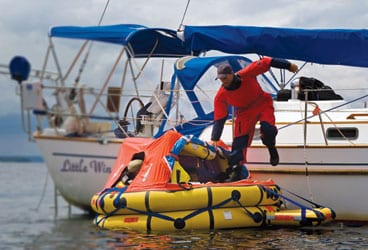
After a full day of climbing into, out of, over, and under a string of new life rafts, I couldn’t decide if it was my jump off the boat or the jump that followed mine that gave me the most pause for thought. The first came about as I stood amidships on Little Wing, the Passport 40 we’d borrowed for the day. It was August in Rhode Island, and I wore my foul-weather jacket and had a life jacket zipped tightly around me. Three feet below and a couple of feet from the deck, the gaping mouth of a Winslow ISO Global Star six-person life raft awaited me and my three colleagues lined up along the rail.
Streaming out behind us were seven more life rafts (a ninth was tested on another day), representative of the latest generation of safety equipment being built to standards now mandated by some offshore-racing and rally organizers. While we weren’t conducting a formal test, the CW editorial team had decided to review the features of each raft, spend some time using them, then pass along our findings to readers to help you consider the many options available.
No time being like the present, I stepped to the lifelines and made the leap. As I landed and slipped quickly to my knees, I felt cold water rush around my legs and up my coat as I scurried out of the entranceway. I’d always wondered how it would feel to abandon ship, and though this was but a drill, that first step from a solid deck to a watery, bouncy raft had been, well, different.
Then came the second jump. With a dull thud, heavy boat shoes hit the life raft’s floor. They came in fast and threatening. The floor pitched, and Doug Ritter, executive director of Equipped to Survive, tumbled into me as he slid out of the doorway and off to the side to make way for the others. Quickly, our consultant on this project, Steve Callahan, the author of Adrift, the chronicle of his 76 days in a raft crossing the Atlantic, and CW managing editor Elaine Lembo followed, with knees and elbows flying. And then there were four of us under the fabric canopy, sizing up the space and imagining what it would be like if we were really calling this home until rescuers arrived, what boarding might have been like if it were taking place at night and in heaving seas, and, most important, how easy, even in these controlled conditions, it would be for someone to be injured-when jumping or when being jumped upon-and for serious complications to quickly set in. Elaine, in fact, was about to get a too-real taste of trouble as we went through our planned assessment drill.
By day’s end, once we’d finished going through the inventory of safety equipment stored aboard each raft, Steve would conclude that, as with most things relating to boats, a lot of compromises had to be made on how each raft was designed, built, and equipped. As a group, we found notable variations in comfort, kit, and construction, but we also agreed that should we find ourselves on a sinking boat far from shore, we’d be pretty relieved to step aboard any of the rafts that we’d looked at.
First though, we had to put these puppies through their paces. As those aboard Little Wing let out our painter, we were pushed backward by the current that in a minute would make it hard for us to swim about in our foul-weather gear, life jackets, and other clothing. One by one we jumped into the water, then used the Winslow’s inflatable ramp and ladderlike webbing that runs across the raft’s interior to pull ourselves back aboard-a maneuver that took a surprising amount of upper-body strength and defied a graceful execution. Then we crowded to one side of the raft, used the strings hanging from the bottom to empty its ballast bags, and flipped it over, taking to the water again. We decided that Elaine, the smallest and lightest, would use the strap across the bottom of the raft to climb up its side and right it. It was hard work and took her a few tries, but soon the raft slowly rose and rolled back onto its bottom-landing on top of a disoriented Elaine. Though she was at the edge of the circular raft, her life jacket and wetsuit pushed her upward and into the floor. Quickly, Steve Callahan sized up the problem and pulled her, sputtering, free. Yes, these rafts are a serious business.
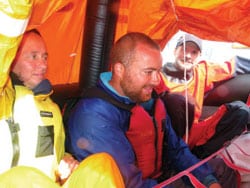
Gretchen Thor | | With 4 square feet per person, even a six-person raft is “cozy” when Sue Pillsbury (left), Mike Lovett, Steve Callahan, and a photographer are aboard. |
A Comparison of Features After consulting on the latest industry trends with Jim and Dan O’Connor, who run Life Raft & Survival Equipment, based in Portsmouth, Rhode Island, Cruising World editors decided to take a look at some of the new life rafts being built to standards drafted by the International Organization for Standardization and the International Sailing Federation, commonly referred to respectively as ISO and ISAF. (See “A Discussion of Life-Raft Standards,” page 64.) These rafts are required aboard sailboats participating in certain offshore-racing events, and often such requirements trickle down to cruiser-based rallies, such as the Atlantic Rally for Cruisers, which now mandates a life raft meeting International Convention for the Safety of Life at Sea (SOLAS), ISAF, or ISO 9650 guidelines. It’s likely, we felt, that this new generation of rafts could create a buzz at boat shows when customers inquire about new products.
The manufacturers that participated in our review included DSB, Revere Survival Products (the sole raft in our study that isn’t built to a particular set of standards but is intended for offshore work), Switlik Parachute Company, Viking Life-Saving Equipment, Winslow Life Raft Company, and Zodiac. In a separate session, we also took a look at a raft that Zodiac builds to specifications developed by West Marine.
Both manufacturers and safety experts on hand for our session were quick to point out that while there are valuable features in these standards-based rafts, there are some tradeoffs, too, primarily because these rafts tend to be heavier and more expensive. Unless one is planning to sail in an offshore race or rally, there may be no need to upgrade from your old raft or pay a premium for one of the models we looked at.
What was clear as the rafts were inflated, one after the other, is that there are a lot of variations to consider. Such factors as raft shape, tube construction, canopy height, floor insulation, door size, and ventilation can have a pronounced effect on comfort and performance offshore. Round rafts are thought perhaps to be more stable, rectangular ones more comfortable for stretching out, and high canopies may make it easier for tall people to sit up for long periods. But stability also depends to a large degree on the form and function of the raft’s ballast bags, while a high canopy that allows for headroom will increase windage, meaning you may drift farther afield from where your EPIRB initially signaled. Of course, if the emergency signal stopped broadcasting, that increased windage might help you drift to shore faster, too.
On the Water To get a look at the rafts, we launched most from a dock, but we saved one packed in a valise and one in a canister to deploy from the deck of Little Wing. Our learning curve began as we carried each raft down the dock to be thrown off. Those packed in hard-shell canisters, which outweigh valises by about 10 pounds, were heavy, and almost all were hard to grip. On a pitching deck, it would be tough work for a shorthanded crew to move one of these about. That said, most canisters sit in a deck-mounted bracket and wouldn’t need to be moved far to reach the rail. Still, some straps or handholds are needed; one offered only a fingertip grip where the two halves of the canister came together. The valises, with their hand straps, were much easier to handle, thought it was tough to imagine lugging one up from below in less than 15 seconds, which is one of the safety criteria cited by U.S. Sailing.
Once each raft was launched, the painter was tugged to fire off the inflating mechanism. Because rafts may be deployed in a wide range of temperatures, there’s extra gas in the inflation canister. We soon got used to the loud hiss of excess gas venting from the expansion valves. Callahan said that in the fury of an emergency, that hissing is often mistaken for a leak. But expansion valves are needed since pressure within the rafts’ tubes changes with temperature and must be allowed to vent.
With the launch of each raft, we witnessed many variations in features: inflatable boarding ramps, ladders made from webbing, fold-down fabric ramps, small doors, large doors, windows, observation hoods, and several different locations where painters might be attached. In the drills that would follow, we’d find that each variation had its pros and cons. Small doors make for good protection from the elements, but landing in such a hole when jumping aboard is harder. Webbing rungs designed for easy boarding can tangle legs. And a painter that keeps the door of the raft facing the opening in the lifelines can make boarding from the water all the more difficult. To me, the biggest takeaway from this preliminary assessment was this: Whatever raft you buy, you’ll be well served to find an opportunity to become familiar with it before you need to use it on some dark night. Dealers and manufacturers either run training sessions or can point you to a third party so you can at least experiment with a similar model. Or better yet, when your raft is due for servicing, your repack station can open it with you in a controlled manner that won’t add wear and tear to the raft.
A Look at the Rafts
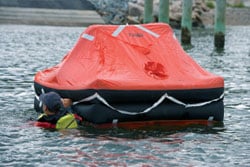
Gretchen Thor | | DSB ISAF Standard |
DSB ISAF Standard: DSB provided a pair of four-person rafts built to ISAF requirements, its ISAF Standard and its ISAF Ocean XR Self-Righting. The Standard, roughly rectangular in shape, comes packed in a valise. At 55 pounds, it’s the lightest we looked at. Inflated, the canopy has a generously sized opening on one side that uses a zipper and hook-and-loop fasteners to seal out the elements; there’s an observation hood, or inspection port, across from it. Outside the entrance, a fabric ramp folds down on webbing, with a web ladder underneath it so you can get a knee up when climbing in from the water. In general, we found it more difficult to climb aboard rafts with fabric rather than inflatable ramps.
The inner floors of both DSB rafts are made from insulated material (think cellular foam) with a surface that reflects heat back into the raft. On these rafts, the floors were attached to buttons in the corners, and both liners came loose as we moved about. We also found that the emergency equipment wasn’t adequately secured and tended to clutter the entranceway as we climbed aboard. Both rafts had conical sea drogues, some of the better we saw, made from a mesh material that would let water pass through.
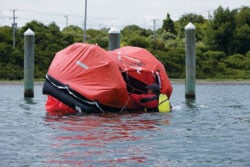
Gretchen Thor | | DSB ISAF Ocean XR Self-Righting |
DSB ISAF Ocean XR Self-Righting: Similar in shape to the Standard but with double arches, the self-righting ISAF Life Raft has an entrance on its longer side, which can be closed with a zipper and hook-and-loop fasteners, and a fold-down fabric entry ramp with webbing below. As in the Standard, there was a good ladderlike mesh of handholds running across the interior of the raft from the entryway, but unlike some rafts, this couldn’t be disconnected when everyone was aboard to get it out of the way. Once capsized, the raft needed only a little push to self-right; in waves it probably wouldn’t have needed help. While four could easily fit in either of the DSB rafts, quarters were tight, and all aboard concluded that if planning for a crew of four, a six-person raft would be worth the added expense. (DSB also manufactures 6-person rafts.) The extra space would also allow each crew to carry his or her own ditch bag, a practice recommended by safety experts. (Go to www.cruisingworld.com/1108ditch for more on ditch bags.)
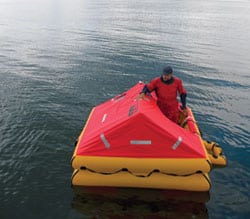
Gretchen Thor | | Revere Offshore Elite |
Revere Offshore Elite: The six-person raft from Revere is built for offshore sailing but not to ISO or ISAF standards. Packed in a valise, it weighs just 63 pounds, making it relatively easy to lift. Inflated, the raft is square, with an ample doorway and a large entrance ramp that inflates with the raft. The raft’s canopy is relatively low and brightly colored for visibility. There’s a quilted inner floor that can be inflated to aid in the prevention of hypothermia in colder water, and a zippered window across from the opening serves as an observation window and provides cross ventilation. The exterior of the raft is well marked with reflective tape, but we found that when launching the raft, it was difficult to find on the valise the black patch secured by hook-and-loop fasteners that peeled off to expose the painter. We also found that the features of the raft itself weren’t as well marked as on some of the other models. Although the raft comes with an older, parachute-style sea anchor, a bonus feature is that it automatically deploys when the raft inflates. On the raft we looked at, safety gear wasn’t tied down well and, as on several of the rafts we capsized, tended to get strewn about.
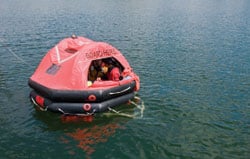
Gretchen Thor | | Switlik MD-3 International Offshore |
Switlik MD-3 International Offshore: The Switlik six-person raft is built to both ISO and ISAF standards and came packed in a valise with lots of handholds that made moving the 97-pound package more manageable. When inflated, the octagonal-shaped Switlik has ample entrances on two sides and clear observation windows on two other sides. There’s a fold-down fabric ramp, with web steps below, in front of one entrance and a web ladder at the other entrance. When boarding from the boat, the Switlik’s main opening can be easily held in front of the lifeline gate because the painter attaches to a triangular bridle anchored to either side of the boarding ramp. However, when a swimmer enters the raft from the water while the raft is still tethered to the boat, this bridle gets in the way and makes it difficult for the person in the water to get a knee in place on the ramp. We found that good handholds made the second entrance an effective alternative for a swimmer. Inside, we found the canopy was well supported and had good headroom, and both entrances featured zippers to seal out the elements.
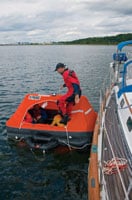
Gretchen Thor | | Viking RescYou |
Viking RescYou: Viking supplied two six-person rafts for our comparison, a standard model and a self-righting model; both are built to ISO and ISAF standards. The square-shaped RescYou standard raft was packed in a valise and weighs 77 pounds. Inflated, the tent-shaped canopy has one large opening whose flap can be sealed with a heavy-duty zipper; there’s an observation port/hood opposite for watchkeeping. At the entrance, there’s a rubber inflatable step with a webbing step that hangs beneath it. We found that this arrangement worked well when boarding from the water. The painter attaches to one corner of the raft, however, so we couldn’t hold the entrance square-on to the opening in the lifelines. The buoyancy tubes on both Vikings are made of two layers of natural rubber with a nylon core, which produces a tough, abrasion-resistant material. Inside both the rafts, the ladderlike handholds, made of webbing, can be untied and moved out of the way. We found well-secured gear bags in these rafts, with sea anchors lashed to them so the drogues could be found and deployed quickly after boarding, if needed. Moreover, Viking uses improved Icelandic-style drogues that have lines on their bridles so they can’t become tangled if they spin in the waves.
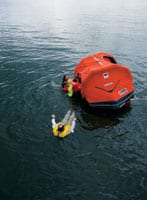
Gretchen Thor | | Viking RescYou Pro |
Viking RescYou Pro: The six-person self-righting raft we inflated came packed in a canister, which helped to make it one of the heavier we launched. The self-righting Pro model, rectangular in shape, has pointed ends that help increase buoyancy, and a well-supported arched canopy. Inflated, it has two large openings that can be sealed tight by flaps with heavy zippers. Like the standard RescYou, the Pro has an inflatable inner floor. All of the rafts we looked at rely on ballast bags that hang below the raft for stability. On several of them, it took two or three people leaning on one side to tip them over, but neither Viking could be tipped without a swimmer in the water to manually empty the ballast bags. Once up-ended, the Pro righted itself unassisted immediately, thanks to the large tubes that support the canopy.
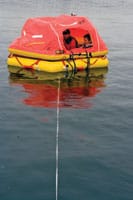
Gretchen Thor | | West Marine ISAF Bluewater |
West Marine ISAF Bluewater: The six-person Bluewater raft is built by Zodiac to West Marine’s specifications with a nylon and butyl rubber sandwich. The raft is hexagonal in shape, which combines with double arches to provide better headroom. The arched, bright-orange canopy has two openings, one with a large self-inflating boarding ramp, the other with a web ladder that extends well below the surface. Both worked well when boarding from the water. A valve in one of the canopy arches on the raft we tested was apparently not seated properly and leaked as we boarded the raft. Our attempt to reinflate the tube was at first successful, but subsequently the hose on the emergency pump broke, a good reminder of Callahan’s advice always to carry a spare pump in your personal ditch bag. Callahan also noted as a plus that the valve used also allows one to reinflate the tube by mouth, if need be. Safety equipment was well secured in the raft, and the gear bag contained a good array of items, including clamps of several sizes to repair the raft in an emergency. The raft has a black inflatable floor that can be pumped up to provide insulation in cold water.
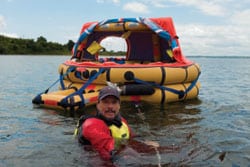
Gretchen Thor | | Winslow ISO Global Star |
Winslow ISO Global Star: The six-person Winslow raft, built to ISO standards, comes packed in a valise and weighs 99 pounds. Of all the rafts, this was the easiest to get into from the boat. Round in shape, it inflates with half of its canopy folded back, creating a large target to jump toward. The canopy can be fully removed for the tropics or zippered front and back to seal out the elements. Zippered windows can be opened for ventilation and for keeping a lookout. An inflatable ramp is found on one side of the raft and a web ladder on the other. We found that features and equipment are well marked; there’s no confusion about where to board, where to grip to right the raft, or what the function of a particular valve is. While the buoyancy bags on some of the rafts took some time to fill, Winslow has come up with a spring system that forces the bags to open and draw in water, so stability is quickly achieved after launching. The idea of internal ladderlike handholds made of webbing, which we saw in several of the rafts, was pioneered by Winslow, and in this raft, the ladder was easily removed with a clip. The Global Star comes packed with well-secured safety equipment, including a spare sea anchor. The primary sea anchor is self-deployed during inflation.
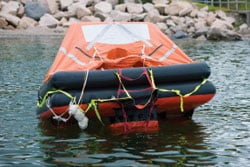
Gretchen Thor | | Zodiac Offshore ISAF |
Zodiac Offshore ISAF: At 95 pounds and packed in a canister, the Zodiac was one of the heavier rafts we launched, though moving it about was made somewhat easier thanks to carrying straps. We did find, though, that the canister, when lying flat and lifted, tended to quickly tip on its side. Inflated, the raft has a tent-shaped canopy and a fold-down fabric boarding ramp and good-sized entrances facing each other across the square-shaped craft. Inside, an aluminum-lined composite cellular foam floor acts as in insulator and reflects body heat back into the raft. The raft we looked at is used by Life Raft & Survival Equipment as a demonstrator and had seen multiple inflations, so we didn’t get a chance to inspect the ditch gear as supplied by the manufacturer. Company literature, however, indicates that it meets offshore ISAF requirements and is secured in a bag.
Mark Pillsbury is CW’s senior editor.
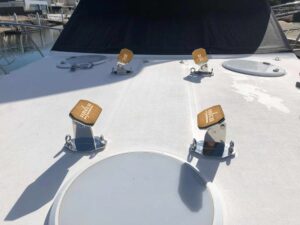
AquaChocks: Secure Tender Storage, Simplified
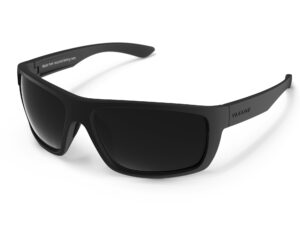
Pro-Grade Sailing Eyewear
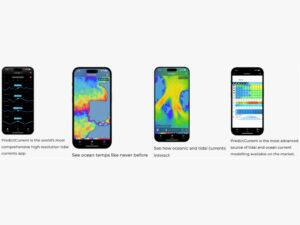
PredictWind Introduces PredictCurrent App

Musto’s MPX Impact is Made for Offshore

Off Watch: School Daze
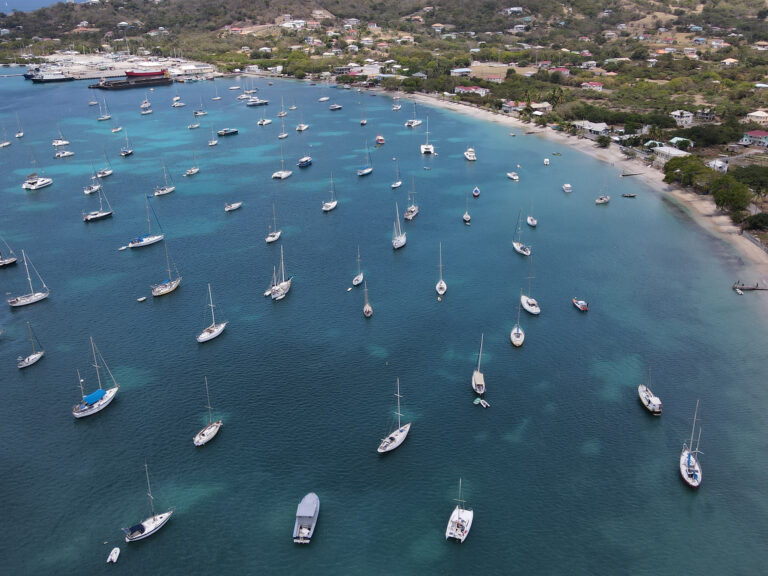
Paradise Pummeled
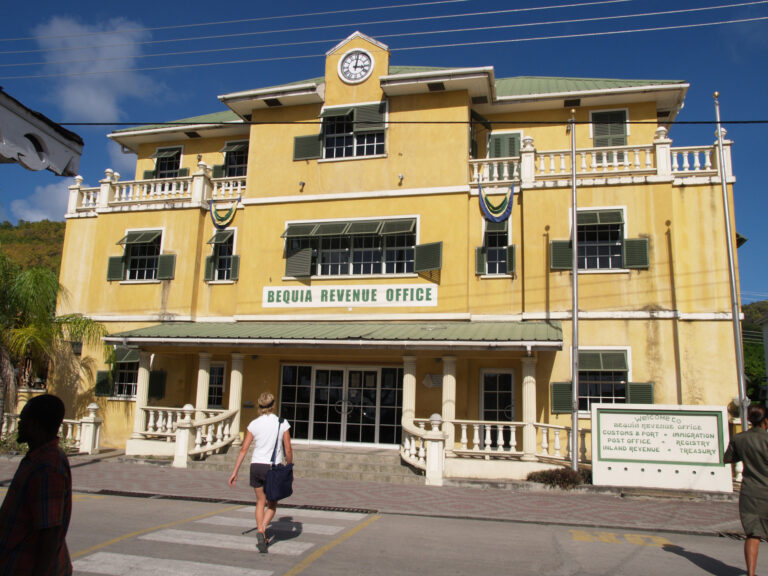
A Guide to Cruising Paperwork

A Superyacht Approach at Southerly Yachts
- Digital Edition
- Customer Service
- Privacy Policy
- Terms of Use
- Email Newsletters
- Cruising World
- Sailing World
- Salt Water Sportsman
- Sport Fishing
- Wakeboarding
Life Raft Rentals
Depending on the type of boating you do, you may want to consider a life raft as additional peace-of-mind. some offshore fishing tournaments and sailing regattas require it. a life raft serves as a floating platform to keep you protected from the elements such as freezing cold water or scorching hot sun in the rare but serious event that you need to abandon your boat..
Exposure in open water is a dangerous thing. Most life rafts have a canopy. This provides minimal protection from exposure and can even collect and channel rain water for drinking. A life raft also serves as a larger visual target for rescuers to see, especially from the air.
Life rafts are carefully packed in a hard case (called a canister) or a soft case (called a valise) and are inflated by compressed gas, usually nitrogen and CO2 stored in a high pressure cylinder. Rafts come in several sizes, typically 4, 6 or 8 man capacity and range in price from around $2,000 to more than $10,000. They weigh anywhere from 20 lbs to 100 pounds.
For more on selecting a life raft, check out the West Advisor section on life rafts . Or, you may try one of the following places that rent them where you will likely have to pick one up. Due to the bulk of these units and the gas cylinders, you’re not likely to find affordable options to have one shipped to your location:
Related Topics:
- About Flares and Distress Signals
- How EPIRBs Work
- Satellite Phone Rental Companies
- Federal Requirements for Recreational Boats
Life Raft Companies
Search for a Life Raft Company in your area by visiting: United States Marine Safety Association — www.usmsa.org
California: Avalon Rafts — Wilmington 310-549-9665 Coast Marine — San Francisco 415-673-1923 Sal's Inflatable Services — Alameda 510-522-1824
Florida: Viking Life Saving Equipment — Miami 305-614-5800 Sun Coast Inflatables — Tampa 888-572-4317 (or) 727-572-4317 Lifeline Inflatable Services — North Miami 305-621-1500
Maryland: Vane Brothers — 800-440-8263
New Jersey: Sea Safety International — Secaucus 201-963-8493
Rhode Island: Life Raft & Survival Equipment, Inc – Tiverton 401-816-5400
Texas: C&M Marine Aviation Services Inc. — Dallas 877-878-4835
Washington: Puget Sound Inflatables, Inc. — Seattle 800-743-7238 (or) 206-762-3877 Westpac Marine Services, Inc. — Tacoma 800-343-5826
Virginia: Vane Brothers — 800-440-8263
- New Sailboats
- Sailboats 21-30ft
- Sailboats 31-35ft
- Sailboats 36-40ft
- Sailboats Over 40ft
- Sailboats Under 21feet
- used_sailboats
- Apps and Computer Programs
- Communications
- Fishfinders
- Handheld Electronics
- Plotters MFDS Rradar
- Wind, Speed & Depth Instruments
- Anchoring Mooring
- Running Rigging
- Sails Canvas
- Standing Rigging
- Diesel Engines
- Off Grid Energy
- Cleaning Waxing
- DIY Projects
- Repair, Tools & Materials
- Spare Parts
- Tools & Gadgets
- Cabin Comfort
- Ventilation
- Footwear Apparel
- Foul Weather Gear
- Mailport & PS Advisor
- Inside Practical Sailor Blog
- Activate My Web Access
- Reset Password
- Customer Service

- Free Newsletter

Whats the Best Way to Restore Clear Plastic Windows?

Beneteau 311, Catalina 310 and Hunter 326 Used Boat Comparison

Maine Cat 41 Used Boat Review

Cheoy Lee Clipper 36 & 42 Used Boat Review

Tips From A First “Sail” on the ICW

Tillerpilot Tips and Safety Cautions

Best Crimpers and Strippers for Fixing Marine Electrical Connectors

Thinking Through a Solar Power Installation

Stopping Mainsheet Twist

Working with High-Tech Ropes
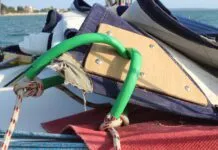
Getting a Clue for the Blown-Out Clew

Monel Seizing Wire is Worth the Extra Cost

Fuel Lift Pump: Easy DIY Diesel Fuel System Diagnostic and Repair

Ensuring Safe Shorepower

Sinking? Check Your Stuffing Box

The Rain Catcher’s Guide

Boat Maintenance for the Technically Illiterate: Part 1

Mastering Precision Drilling: How to Use Drill Guides

Giving Bugs the Big Goodbye

Galley Gadgets for the Cruising Sailor

Those Extras you Don’t Need But Love to Have

UV Clothing: Is It Worth the Hype?

Preparing Yourself for Solo Sailing

How to Select Crew for a Passage or Delivery

Preparing A Boat to Sail Solo

On Watch: This 60-Year-Old Hinckley Pilot 35 is Also a Working…

On Watch: America’s Cup

On Watch: All Eyes on Europe Sail Racing

Dear Readers

Chafe Protection for Dock Lines
- Safety & Seamanship
Life Rafts: The Good, The Bad and The Ugly
Part 1—extensive in-water tests and examinations of 25 rafts find considerable differences in stability, comfort and safety equipment. here’s help in identifying the most important features..

by Douglas S. Ritter

With lives at stake, we expect manufacturers of safety equipment to value our lives, and those we care about, as much as we do. Unfortunately, that isn’t always the case, as we discovered yet again when we evaluated life rafts. Mind you, all the rafts tested could save your life if everything goes right, but we’re inclined to believe that is not likely always going to be the case, otherwise why would you bother with a life raft in the first place?
We evaluated three inshore, eight coastal and 14 offshore life rafts, in four- or six-person capacities, from nine manufacturers: Crewsaver by Eurovinil (Italy), DBC Marine Safety (Canada), Givens Marine Survival (U.S.), Plastimo (France), Survival Products, Inc. (U.S.), Switlik Parachute Co. (U.S.), Viking Lifesaving Equipment (Denmark), West Marine by Zodiac (France), Winslow LifeRaft Co. (U.S.), and Zodiac International (France). Avon declined to participate, citing the unavailability of their completely revised product line with manufacturing just under way in Hungary. RPR Industries, which formerly manufactured the Givens rafts and now is manufacturing a similar raft on its own, declined, citing pending legal issues involving Givens. Eastern Aero Marine also declined and RFD/Revere and BFA failed to return our calls or e-mails.
Part 1 covers our general findings. Parts 2 and 3 report our findings with coastal and offshore models.
Performance tests were conducted in a wave pool to ensure consistent conditions. Volunteers attended from throughout the U.S. and Europe. They ranged from unsuspecting “life raft virgins” who had never been in a life raft before, to experienced survival instructors. Following three days of exhausting in-water work, we conducted detailed evaluations of the rafts and their survival equipment.
Two volunteers developed rashes covering their exposed skin. It was unclear whether this resulted from an allergic reaction or from the abuse of testing. If this is a concern, request a sample of material to test before purchasing.
The evaluations were conducted in cooperation with Equipped To Survive (www.equipped.org). The United States Coast Guard sent two representatives, their senior rescue swimmer, Master Chief Keith Jensen, and Lieutenant Commander Paul Steward from the Office of Search And Rescue.
Expectations You can’t expect a small valise or canister weighing from 12 to 100+ pounds to afford the luxury of a yacht. The option of last resort, a life raft should be capable of delivering its occupants to safety, even through weather and seas that may have contributed to the loss of the mother vessel. That’s a lot to ask of anything, let alone some inflatable contraption made of fabric and little else.
The rafts tested ranged widely in price, features, and capability. When all was said and done, our overriding concern focused on capability—would it save our lives?
As we spent hours, days and weeks with these rafts, a related concern came to the fore. The raft must be designed and equipped to take care of the survivor; it should demand little or nothing of the survivor, who may be unable to do much on his or her behalf. Everything should be obvious and intuitive to survivors who most likely have no survival training.
A life raft is an integrated system in which the performance of individual features, or lack thereof, can significantly affect overall performance. The devil is often in the details.
Choosing a raft can be difficult. The selection is confusing and the terminology often doesn’t clarify issues. With little in the way of standards for non-commercial rafts, manufacturers can pretty much make whatever claims they want to.
Criteria For Evaluations In evaluating the rafts we were concerned with a number of attributes: ease of deployment and operation; seaworthiness and stability; ease of entry, both from the vessel and the water; protection from the sea and elements; functionality; livability; comfort; survival equipment selection and quality; and of course, price. Some of these are more critical than others, but all have a bearing when making a choice.
Size Does Matter The space available to each survivor has a huge impact on livability. SOLAS/USCG-approved rafts use, as one measure, a minimum of 4 sq., ft. per person. While popular opinion seems to be that non-approved rafts often don’t meet this standard, virtually every raft we reviewed did, though only a few exceeded it by any significant amount. Winslow’s Ocean Rescue took top honors with half again more space per person. While configuration can make a difference, any way you slice it there isn’t much room. Think sardines. Lay open this publication on the floor and multiply it by three. Imagine spending a few days in that space.
If you can afford a few extra dollars, pounds, and a few inches, seriously consider going up one or even two sizes, but only if you purchase a well-ballasted raft. For example, if you need a four-person raft, upgrade to a six-person, which is essentially what Winslow has done with its Ocean Rescue model. In a raft with minimal ballast, it is better to stick with the rated capacity, maximizing the ballast effect of the survivors.
Pick A Shape Rafts come in three basic shapes: round or nearly so (5-, 6-, 8-, 10- and 12-sided), square, and elliptical or boat shaped (rectangles, and elongated heptagons and octagons).
All other things being equal (they rarely were in any of our raft evaluations), a square or elongated raft may provide more comfortable seating with survivors side-by-side, alternating one way and another, though things can get messy at the ends in some rafts. In all but the most spacious round rafts, everyone’s feet generally tangle in the middle when stretched out, which can get uncomfortable.
A raft’s drogue (called a “sea anchor” by some) is an important and often under-rated element in the stability and seaworthiness of all rafts. As a raft starts to come out of the water a drogue can provide significant added resistance to capsizing. For a square and especially a boat-shaped raft, however, it is more critical. A boat-shaped raft, running with wind and waves, is probably somewhat less likely to overturn, in this case end-over-end, than a comparably sized and ballasted round raft, all other things being equal (again, usually they are not).
Unfortunately, drogues are often lost in heavy weather. If a round raft loses its drogue, it may carousel, but it generally has no inherently less stable configuration. Lose the drogue on a boat-shaped raft and it is likely to quickly turn broadside and settle in a wave trough, as would a boat without steering. Unless the ballast compensates, it is then more likely to capsize in conditions that might otherwise not cause a problem.
Multi-sided equilateral rafts, especially those with six or more sides, can have a structural advantage over round or elongated rafts. The short-coupled reinforced mitered joints can provide significant added rigidity, which was evident reviewing video tapes of our tests.
One Tube Or Two? Another obvious distinction between rafts is whether they have a single tube for floatation or if they use two stacked tubes. Many Coastal rafts have only a single tube. The difference in freeboard is significant. In rough weather, the more freeboard you have, the better. With double tube rafts, larger tubes provide greater freeboard and more reserve buoyancy.
Twin tubes also offer a much more supportive backrest; the single tube rafts were deemed much more uncomfortable. Also, higher sides are necessary to brace oneself against the violent motion of the raft in bad weather.
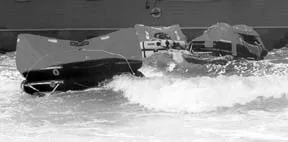
Redundancy Inflatables, while pretty darn tough, are still subject to puncture by any number of means. Even in closely supervised training, rafts are often punctured.
We feel strongly that there must be means to ensure that if there is a puncture, then some buoyancy remains. Whether by having multiple tubes or by dividing up a single tube internally, puncturing one buoyancy chamber should not sink the whole raft. The DBC and Plastimo coastal, and all three inshore rafts, were deficient in this regard.
However, buoyancy doesn’t necessarily mean you’ll stay dry. In most single-tube rafts the tube is divided in half by vertical bulkheads. If one chamber deflates, survivors in that half are going into the water and everyone is going to get wet. You are left with a half circle of tube open to the water across the diameter, like a donut broken in half. Even a partial deflation presented problems for our volunteers, swamping the raft.
Switlik’s CLR6 USCG Coastal Mk II addresses this problem with internal sleeves that expand to fill the deflated half of the raft. This leaves the entire raft inflated to approximately 50%, which can be topped off without first repairing the puncture. In our tests, however, it wasn’t enough to keep the raft from being partially swamped. Better, but not nearly as good as two tubes.
The practical advantages of single tube rafts are weight and space savings. They generally cost a good deal less, though not just because they are single tube designs.
Deploying The Raft As soon as we started unloading and moving the rafts around the issue of weight was raised by the volunteers. Even with two people, dealing with some of the heavier rafts was a burden. The critical question became, “How could one possibly deploy a heavy raft under trying conditions, if exhausted from fighting a storm, or if short-handed?”
The weight and volume of the raft is affected by its capacity, its design, additional features, and the materials from which it is made. Other things also contribute to overall weight. A canister is generally heavier and more bulky than a valise. The selection of survival equipment also can make a huge difference in overall weight.
Being unfamiliar with exactly how each raft would be deployed, the virgins often had some difficulties caused by either misunderstood directions printed on the raft or difficulty performing the inflation procedure. Neither written nor pictorial instructions alone seem to be entirely adequate. Some of the English translations provided a few laughs.
If possible, attend a deployment demonstration. The Zodiac and West Marine rafts came with an instructional video, which while not great, were better than anyone else provides. At the least, take time to review the deployment instructions ahead of time, when you can concentrate on them without distraction.
The painters (mooring lines), which are tied to the boat to prevent the raft from being blown away, varied in length from a much too short 22′. (Plastimo Coastline), to a possibly excessive, 125′. (Switlik CLR6). SOLAS calls for “15 meters” or about 50′. Painter failures after deployment have resulted in rafts being lost before boarding. Many suggest that the weak link in these painters, which prevents the raft from going down with the vessel, should be stronger than the 500 lbs. mandated. Trying to haul in a raft at the end of a 100+’ line, against the seas and wind, can take time and strength that aren’t available. We are not convinced that painters in excess of 50′ are necessary or desirable.
The painter should always lead directly to the primary boarding station. In some rafts, the West Marine Offshore, for example, it leads to the alternate boarding station with less capable aids. In others, the Switlik MD-2 for example, it doesn’t lead to a boarding location at all and the instructions, once you reach the raft, don’t make it clear which way to go to the primary boarding station.
While only two rafts inflated upside down, it is always a possibility. Only the Givens seemed to have any significant self-righting tendencies when empty. With no wind or heavy seas to deal with, righting was relatively easy for most, but it was obvious that under real world conditions some would be much more difficult to right than others due to inadequate aids, the lone handhold of the DBCs and Viking being good examples.

More critically perhaps, righting instructions were often woefully deficient; volunteers ignorant of the proper technique weren’t helped much. At night, for most of the rafts, forget it. The Winslows, with excellent righting aids and an exclusive “righting locator light,” were applauded.
All Aboard! How easy will it be to jump into the raft from the boat? The Winslows and the Switlik SAR Mk II have large canopy openings, making boarding easy. Others, Givens and DBC for example, have small openings that would make it more difficult and potentially dangerous.
Boarding from the water, the effectiveness of the boarding aids is absolutely critical. Some rafts with minimal aids and little more than a few loops of line for assist—Givens, Zodiac, and Viking—were virtually impossible for some volunteers to board without assistance, which may not be available. Without considerable upper body strength, you’re in trouble. Short and bottom heavy volunteers especially had difficulties, but anyone who is injured or exhausted from fighting a storm could have difficulty. A few rafts made it relatively easy, including Winslow with its ample outside and inside ladders, stirrups, and grab handles; Switlik’s “step” on most of their rafts; and the West Marine Offshore and DBC Swiftsure Global with their inflatable “ramps.”
Staying Sunnyside Up The stability of the raft is critical. Survival accounts are filled with tales of rafts capsizing again and again, usually losing precious supplies and sometimes lives. The 1998 Sydney-Hobart Race was but the latest well-publicized example.
Ballast is your primary means of preventing a capsize. From a practical standpoint, ballast in a raft is limited to the people and equipment in and on the raft and some means of retaining water below the raft to counteract the tendency to capsize as it lifts out of the water.
Experience shows that raft occupants are of limited value in terms of ballast, especially if there are fewer than the rated capacity. What happens if you have a six-person for your for-person crew, but only two of you make it into the raft? A raft bottom even slightly raised off the water by wave action can be easily caught by the wind and the raft capsized in an instant…unless something either blocks or opposes the force of the wind.
Ballast effectiveness is determined by the capacity of the water retention devices, their configuration, and their placement. All the non-U.S.-manufactured rafts use similar, marginally effective ballast systems–V-shaped bags hanging below the raft. Capsizing them was a trivial matter. U.S. manufacturers provide more capable, higher capacity ballast systems, ranging from box-shaped bags on the Winslows and Switliks to the unique Switlik “toroidal” ballast on its SAR MkII, and Givens’ “hemispherical” design. Another consideration, particularly with regards to boarding, is how quickly they fill with water. With the exception of Winslow and Givens, all had weights to assist in rapid filling, though results were mixed.
Is there such thing as too much ballast? Possibly, in the sense that “excessive” ballast may compromise other seaworthiness-related characteristics, but better too much than too little as far as we’re concerned. In our opinion, the non-U.S. entries and inshore rafts all were deficient.
What A Drag As noted earlier, the drogue is an integral part of the life raft system. To function properly as a stabilizer, to slow drift and help counter capsizing action, it must be strong enough to not be torn off in heavy seas, provide sufficient drag to be effective, offer adequate rode length and at least a single swivel to cope with heavy seas, must not tangle and must not collapse when subjected to repeating wave action. Two styles are common, the conical and the “parachute” or “hemispherical” style. Both have their pros and cons, but if properly designed, each can do the job. In our tests, Winslow’s hemispherical drogue was tops in drag. The best of the rest offered about half its performance (Viking, DBC, and Winslow conicals and the West Marine chute). The remainder we deem inadequate.
Only Winslow and West Marine use swivels on the drogue. These are essential to eliminate twisting of the rode, which is believed to be the primary cause of failures. Only the Plastimo Coastline lacked a drogue, but some of the rodes were too short, as little as 16.5′ for the Switlik CLR6. None of the drogues on a short rode performed well—we consider 75′ the minimum and double that wouldn’t be too much. We also prefer the heavier line used with many of the drogues as opposed to lightweight parachute line found on the Winslow, Givens and many of the Switliks.
While some manufacturers require the survivor to deploy the drogue, we prefer self-deploying drogues—one less thing for the survivor to worry about. The drogue should orient the raft so that the entry(ies) and vulnerable portions are sheltered.
Shelter A weathertight canopy is essential in adverse weather conditions. All the life rafts ,excluding the inshore platforms, were equipped with self-erecting canopies that use an inflatable arch or arches for support. No tester had a single good word to say about the single arch canopies. “Better than nothing” about summed up the sentiment. Particularly with single tube rafts, but even with double tubes, headroom is seriously compromised—sitting hunched over gets extremely uncomfortable. The twin- or tri-arch designs on the Givens, West Marine and Winslow offshore, and Switlik’s MkII rafts are vastly superior.
A bright orange canopy is vital for being found, but SOLAS requires a blue interior for its supposed calming effect. Many canopies were either white or orange inside, turning everyone inside a sickly orange shade. On the other hand, they were at least brighter inside. With the exception of the Winslows that were fitted with unique clear viewing and ventilation ports, the others’ opaque blue interiors became black holes when closed up. One volunteer said of the Givens that it “felt like I was locked in a crypt.” Some rafts were equipped with an interior light, which we feel is essential, but for the most part even those were only marginally effective. The Winslow “viewports” were widely lauded, both for contributing to a psychologically more comforting environment and as a potential antidote to seasickness, a serious concern for survivors.
Wet and Cold Leaks A canopy that leaks is not nearly as comfortable or effective as one that really keeps the weather out. Two issues arise here—effectiveness of the closure system on the canopy openings and ease of use. All the closure systems are a compromise, but overall we prefer ease of use that doesn’t require much manual manipulation. Digital dexterity is one of the first things lost as a result of exposure.
Zippered closures, at least those with large zippers and helpful zipper pulls, such as Winslow’s and Switlik’s, are the easiest to use and fastest canopies to close up. Closures using cloth ties can be difficult in cold weather. We had problems with some of them, such as the Givens, even in calm and warm conditions. Tie systems are inevitably less waterproof than a well-designed zipper system with good storm flaps, but exposed zippers, such as those used on some of the Switliks, leaked water.
A good entry design allows for ventilation at the top as the entry is closed up, not down. Switlik and West Marine are good examples of this. Winslow counters with an entry that zips down, but is equipped with a double acting zipper. The opening viewports provided in all but their base models were very popular with the volunteers, though they lack weather protection. Viking, Plastimo and Zodiac provide few options except closed or open, a deficiency well noted by the testers.
Insulated Floors An insulated floor is important, even in temperate waters, though it is optional on most rafts, unavailable on some. Zodiac and West Marine use a thin layer of foam with a reflective surface integral with the floor. The effect of UV on the reflective surface in the tropics gives us pause, and the foam was ripped up in places even from our short test period. The Plastimo Offshore+ had a tied-in foam sheet that was a real nuisance. Winslow, DBC and others offer integral inflatable floors, some with reeds, others without, a less desirable design. Crewsaver, Viking and Switlik offer drop-in inflatable floors, much like an air mattress. Switlik also offers a drop-stitch drop-in inflatable floor. This floor becomes an almost rigid structure 2.5″ thick, easily the most comfortable of the options, though they are quite heavy. In our experience, the Zodiac foam floors aren’t as effective or robust as the best inflatable floors, with Winslow’s and the drop-stitch from Switlik leading the pack.
Equipment The selection of raft and survival equipment included with each raft ranged from utterly deficient to reasonably well equipped. Inshore and coastal rafts especially were shortchanged. Many didn’t include the most basic signaling device, a signal mirror. Often the quality of equipment was also questionable. You’d be in the dark, for example, if you relied on DBC’s choice of flashlight—three out of three were defective.
With the exception of the U.S.-influenced West Marine rafts, we were particularly unimpressed with the raft repair supplies used by the non-U.S. manufacturers. The patch kits all suggest you first dry the materials to be bonded—hardly welcome instructions in a wet life raft! Most suggest waiting a period before re-inflating. Don’t even think about using them below the waterline. The wood, rubber and plastic plugs are effective as a stopgap measure, but not great for long-term use. All the U.S. and West Marine rafts included mil-spec raft repair clamps that are very effective.
Generally speaking, you’d best plan on supplementing the raft’s equipment with your own. The less expensive the raft, the more equipment you’ll need to provide yourself.
Where To Put It? One of the most difficult questions is whether to buy a container or valise, and where to put it. The smaller the boat, the more pressing the problem.
A container generally means finding space where it will least be in the way. Only of late are some boatbuilders, mostly of larger boats, providing a dedicated space for a life raft that also aids in launching it. The most common spot, otherwise, seems to be on deck before or behind the mast. The downside of this location is accessibility. If everything has gone to hell in a hand basket, do you want to have to go forward to get the raft, possibly through a tangle of downed mast and shrouds, and somehow launch it from an exposed position? Could you even make your way forward if things are really bad? What if the reason for abandonment is a fire in the galley or engine room that is between you and the raft?
Center cockpit boats or those with a small afterdeck may find space aft, which alleviates these concerns. Some mount the flat-pack style vertically on the transom, but we think that too exposed.
Canisters also present some other considerations. Good ones are heavy, adding weight to the often already heavy raft, complicating launching. Can you slide it under the lifelines or do you need to go over them? One Switlik canister we tested weighed 28.6 lbs. The rest of the canisters we deemed tough enough to survive on deck weighed in around 20-24 lbs.
Even the best ones are not totally waterproof, to some degree leaving your rafts exposed to the elements, though vacuum packing the raft will fix that. However none of the rafts thus packed came with canisters that were robust enough for us to recommend.
Finally, we’ve all read of instances in which deck-mounted rafts were swept overboard. Properly securing the optional cradle and raft is not something to be taken lightly, often adding to initial cost. Plus there is the matter of security. You can padlock the raft down when ashore, but will you always remember to unlock it before shoving off?
Does a hydrostatic release make sense on a sailboat? In large part it depends where the raft is stored and what the chances are that it will release and not tangle in the lines and shrouds. We’re not convinced of their value and don’t consider them essential. Most require replacement every two years at a cost of around $150.
A valise presents its own compromises. While lighter and less bulky, it must be protected from the weather, meaning it’ll need to be stowed either down below or in a locker in or around the cockpit. Down below means you have to go below to retrieve it—not the very best of arrangements. A cockpit locker can limit raft size, though some boats are now being built with this in mind. Winslow is the only manufacturer that offers “custom dimensional packing” to fit available space.
Our preferred location is in or around the cockpit. That’s the best place, generally, from which to launch the raft and the safest place for survivors to congregate for boarding, with easiest access to stores below, if time allows.
In A Vacuum? Vacuum packing, as used by Zodiac, West Marine, Crewsaver and Plastimo, can save money on initial services, which is appealing. It also does a better job of protecting the raft from the elements. Even many who don’t currently vacuum pack their rafts confided to us that they expect to eventually move in that direction.
Next month, in the second installment of this series, we’ll take a closer look at the inshore and coastal rafts evaluated.
Doug Ritter is a Practical Sailor contributing editor and the editor of the web site Equipped To Survive (www.equipped.org).
RELATED ARTICLES MORE FROM AUTHOR
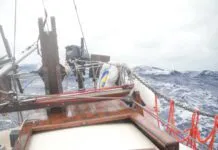
Responding to Emergencies: A Skipper’s Guide for Staying Calm
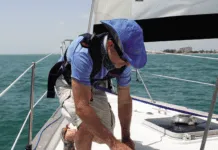
Sailboat Safety on Deck

Master the Sailing Basics: Never Stop Learning the Little Things
Great article, I have Jim Buoy now eight man raft that I keep on the roof of my center consul but it’s in bad shape and I want to replace with one in a soft case. My boat is a 26’ center console and I fish 50-70 miles out in the Gulf with never more than 4 of us usually 3. What should I buy? Thanks Bill
Darrell Awesome article and badly needed due to marketing online. I think the single most important tool for any life raft is an EPIRB because it will likely determine how long you will be in the raft. Amazingly boat survey personnel blow off the review of the raft with a quick review of the tag. My survey said tag not visible. It was pretty clear to me that the 2006 boat raft would need an upgrade before crossing an ocean. Stowed in a cockpit locker my 120 pound lady has no hope of deployment on her own. Also drinking water is the next primary concern in my opinion. Having a way to collect condensation is paramount to an extended survival period. Food for thought Cheers!
LEAVE A REPLY Cancel reply
Log in to leave a comment
Latest Videos
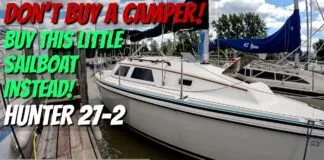
The Perfect Family Sailboat! Hunter 27-2 – Boat Review

Pettit EZ-Poxy – How to Paint a Boat

The Boat From True Spirit – Sparkman & Stephens

Top 5 Boat Hacks – Boat Maintenance Tips and Tricks
Latest sailboat review.

- Privacy Policy
- Do Not Sell My Personal Information
- Online Account Activation
- Privacy Manager

NYK Group To Time-Charter Its First Methanol-fueled Bulk Carrier


Containership Loses Nearly 100 Containers In Severe Storm Off South Africa

World’s First Electric Flying Hydrofoil Passenger Ship Delivered To Saudi Arabia’s NEOM

Massive Fire Erupts On Soviet Aircraft Carrier Docked In China’s Yangtze River

The Complete Guide To Liferafts on Ships
Life rafts are survival equipment provided as a life-saving appliance on every seagoing merchant or passenger ship, in addition to the lifeboats .
Life rafts are much easier to launch than lifeboats. In emergencies, evacuation from the ship can be done without manually launching any of them, as the life rafts are designed with an auto-inflatable system.
SOLAS Chapter III gives all the details for the types, and the number of life rafts to be carried according to the size and type of the ship.
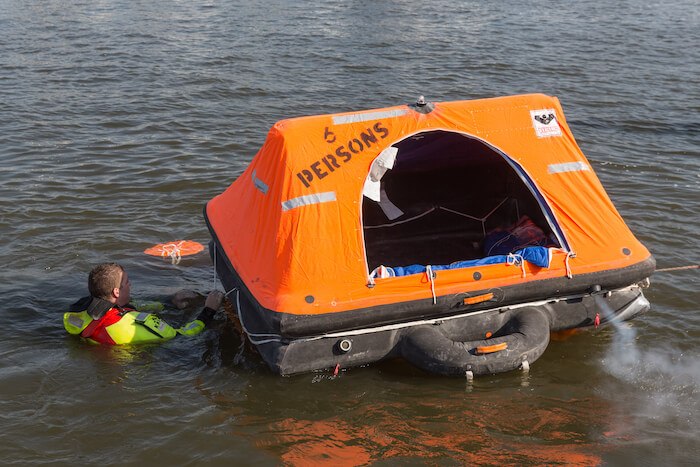
Table of Contents
Where Are Liferafts Located On Ships?
Life rafts are typically located on the muster station, on the port and starboard side near the lifeboat, and on the aft of the ship. The location generally depends on the size of the ship.
Life rafts are stored in a fibreglass container, and a high-pressure gas inflates them during an emergency.
A Hydrostatic Release Unit (HRU) is connected to the raft container and ship, which releases the raft even after the vessel sinks in water.
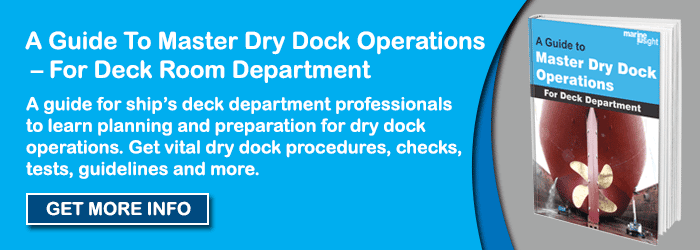
The particulars of the raft are stencilled on the container, which includes the capacity, manufacturing date, servicing date, company name, etc., along with the launching procedure with a photogenic display for easy understanding.
The raft already contains the essential survival items, including rations, pyrotechnics, life jackets, etc.
Some ships carry a davit launching system allows the crew to inflate and board the raft on the deck, avoiding the risk of seawater entering.
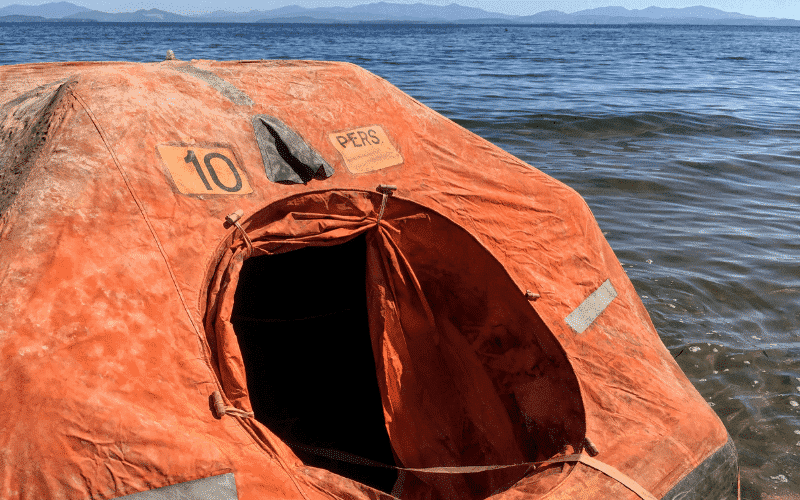
Important Solas Requirements For Life Rafts
- All liferaft provided on ships should be bestowed with its painter permanently attached to the vessel.
- Each liferaft or group of liferafts should be stowed with a float-free arrangement complying with the requirements so that each floats free. If it is an inflatable raft, it should inflate automatically when the ship sinks.
- Liferafts should be stowed to permit the manual release of one raft or container at a time from the securing arrangements.
- Davit-launched liferafts should be stowed within reach of the lifting hooks unless some transfer is provided, which is not rendered inoperable within the limits of trim and list as required or by ship motion or power failure.
- Liferafts intended for throw-overboard launching should be stowed to be readily transferable for launching on either side of the ship.
Related Reading:
- Survival At Sea: How To Stay Afloat In Water
- How to deal with health problems in a survival craft
- 6 Ways to Find and Conserve Drinkable Water at Sea
Servicing of Liferafts
All liferafts shall be serviced:
- at intervals not exceeding 12 months (if impracticable, the administration may extend this period to 17 months)
- at proper service stations with proper servicing facilities and trained professionals
Davit-launched liferaft automatic release hooks should be maintained following instructions for onboard maintenance
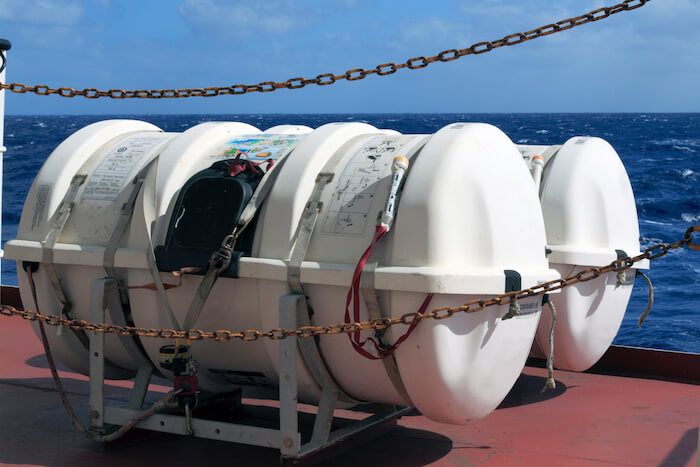
Essential Requirements for Liferafts and Carrying Capacity
The liferaft of any ship needs to follow the regulations mentioned in SOLAS. Some of the important points regarding liferafts are:
- The lift raft should be capable of withstanding exposure for 30 days afloat in all sea conditions
- When dropped into the water from a height of 18 metres, the life raft and all equipment in it will operate satisfactorily.
- The floating life raft should be capable of withstanding repeated jumps on it from a height of at least 4.5 metres above its floor, both with and without the canopy erected.
- It can be towed at 3 knots with its complete equipment, complement of persons and one anchor streaming.
- Canopy to provide insulation and protection against heat and cold by two layers of material separated by an air gap
- Interior to be of a non-discomforting colour.
- It shall admit sufficient air for the occupants at all times, even when the entrance is closed
- It shall be provided with at least one viewing port
- It will be given with a means of collecting rainwater
- It shall be provided with a tool to mount a survival craft radar transponder (SART) at the height of at least 1 meter above the sea level
- It shall have sufficient headroom for the sitting occupants under all parts of the canopy
- The minimum carrying capacity must be at least six persons
- The maximum weight of its container, as well as the equipment, should not exceed 185 kilos
- The life raft shall be fitted with an efficient painter of length equal to the minimum of 10 metres plus the distance from the stowed position to the waterline in the lightest seagoing condition or 15 metres, whichever is greater
- A manually controlled lamp shall be fitted on the top of the canopy, and the light shall be white, and it must operate for at least 12 hours with a luminous intensity of not less than 4.3 candela
- If the flashlight is fitted, it shall flash at a rate of not less than 50 flashes and not more than 70 flashes per minute for the 12 hours that it burns
- A manually controlled lamp shall be fitted inside the life raft, capable of continuous operation for at least 12 hours
- When the liferaft is loaded with a full complement of persons and equipment, it should be capable of withstanding a lateral impact against the ship side at an impact velocity of not less than 3.5m/s and also drop into the water from a height of not less than 3 metres without damage
- CO2 does inflation with a small quantity of N2, which acts as an anti-freezing element. Also, CO2 is non-flammable and weighs more than air, adding buoyancy to the raft. The freezing point of CO2 is -78 degrees so that it can inflate life rafts at shallow temperatures
- Location on a ship: – Forward – At embarkation stations on both port and starboard sides
- The painter breaking strength should be: – 15kN for 25 people and more – 10 kN for 9 to 24 people – 7.5 kN Rest (6-9)
Safety Features on a Liferaft
Some of the main safety features on a liferaft are:
- Pressure relief valve
- Stabilizing pocket
- Insulated canopy with two layers for protection against heat and cold
Important Liferaft Equipment
All liferafts on ships are fitted with the following equipment:
- Rescue quoits with minimum 30-metre lines
- Non-folding knives with buoyant handles
- For 12 persons or less, one bailer. For more than 13 persons, 2 bailers should be kept.
- Two sponges
- Two buoyant paddles
- Three tin openers
- Two sea anchors
- One pair of scissors
- One first-aid waterproof kit
- One whistle
- One waterproof torch for communicating Morse code with one spare set of batteries and a bulb
- One signalling mirror/heliograph
- One radar reflector
- One life-saving signal waterproof card
- One fishing tackle
- Food ration totalling not less than 10000 kJ for each person
- Water ration- 1.5 litres of fresh water for each person
- One rustproof graduated drinking vessel
- Anti-seasickness medicine is sufficient for at least 48 hours, and one seasickness bag for each person.
- Instructions on how to survive (Survival booklet)
- Instructions on immediate action
- TPA is sufficient for 10% of the number of persons or two, whichever is greater
- Marking shall be SOLAS ‘A’ Pack
- 6 Hand Flares
- 4 Rocket Parachute Flares
- 2 Buoyant Smoke Signals
Markings on a Liferaft Container
Important markings provided on a liferaft container are:
- Maker’s name and trademark
- Serial number
- Name of Authority
- Number of persons carried
- SOLAS emergency pack enclosed
- Date of the last service
- Length of painter
- Maximum height of stowage
- Launching instructions
Markings on an inflatable Liferaft
Important markings provided on an inflatable type of liferaft are:
- Serial Number
- Date of manufacture
- Name of approving authority
- Name and place of the last service
- Number of persons permitted
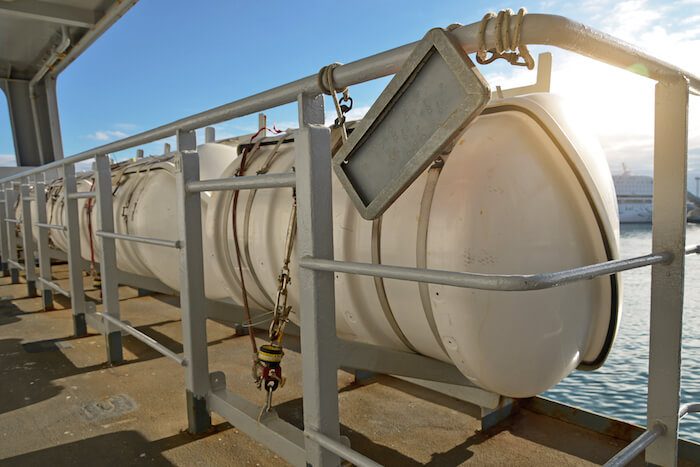
Launching of a liferaft when the ship sinks and HRU activates (Auto)
A general overview of the launching procedure of a liferaft when the ship sinks is as follows:
- When the ship sinks up to 4 metres, the water pressure will activate a sharp knife in the HRU
- It will cut the securing rope around the container/canister of the raft, and the raft will float free
- As the ship sinks further, the painter line will stretch, and it will inflate the life raft
- Due to the increase in buoyant pressure, the weak link will break at around 2.2 kN +/- 0.4, and the raft will be on the surface.
Read: Liferaft release system and launching procedure
Launching the life raft manually
- Take out the painter of the raft
- Fasten it to the ship side at a strong point
- Remove the railing and check overboard for any obstructions
- Unfasten the hook from the cradle
- Two people can lift the life raft and throw it overboard
- After it’s thrown, pull the painter sharp until the life raft inflates
- With the painter, pull it towards the ship’s side
- Lower the embarkation ladder or jump directly onto the life raft, depending on the situation and the time at hand
- Sit wide order face to face to prevent any imbalance
- Ensure SART and EPIRB have been carried
- Take a headcount
- Cut the painter using the knife, paddle, or anchor, clear away from the ship.
If the life raft inflates and is upside down, the raft has a righting strap capable of stabilizing it. Climb onto the CO2 cylinder and pull it in the same direction as the wind to do so.
Watch: How to launch and board an inflatable liferaft?
Launching the life raft by the Davit
- Remove the ship’s handrail
- Remove lashings from the container
- Lower the davit and lock it with the lifting shackle
- Secure canister lines outboard
- Secure browsing line
- Pull the painter out approximately 5-6 metres
- Secure the painter’s line
- Pull the entire length of the painter
- Now lift the life raft canister to some height
- Pull the painter sharply and let it inflate
- After it inflates, secure the liferaft
- One person should go in and make some checks
- Collect the SART and EPIRB
- Go inside and sit evenly
- Release the bowsing line and pass to the raft
- Check if the launching area is clear
- Lower the raft using the brake release
- Operate hook release 1m above the water or allow the raft to ride a crest of the wave to put the load on the water, and it will automatically release
- Cut the painter and clear away
You might also like to read
- Types of Lifeboat Release Mechanisms And Solas Requirements For Lifeboats
- Measures To Stop Accidents On Lifeboats
- Survival at Sea: How to Safely Beach a Life Boat?
- Enclosed Lifeboat Release Accidents: Reasons And Prevention
- Types of Life-Saving Equipment Onboard Ships
- Concept: A Life Raft that Makes Drinking Water from Seawater

About Author
Shilavadra Bhattacharjee is a shipbroker with a background in commercial operations after having sailed onboard as a Third Officer. His interests primarily lie in the energy sector, books and travelling.
Read More Articles By This Author >
Disclaimer : The information contained in this website is for general information purposes only. While we endeavour to keep the information up to date and correct, we make no representations or warranties of any kind, express or implied, about the completeness, accuracy, reliability, suitability or availability with respect to the website or the information, products, services, or related graphics contained on the website for any purpose. Any reliance you place on such information is therefore strictly at your own risk.
In no event will we be liable for any loss or damage including without limitation, indirect or consequential loss or damage, or any loss or damage whatsoever arising from loss of data or profits arising out of, or in connection with, the use of this website.
Related Articles
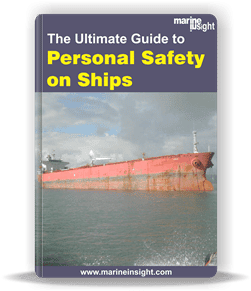
Free eBook – The Ultimate Guide to Personal Safety on Ships
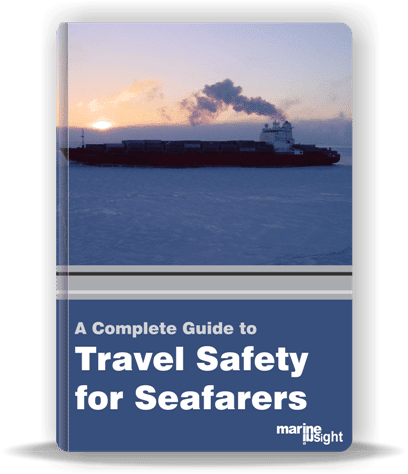
New eBook Launched – A Complete Guide to Travel Safety for Seafarers (With FREE Checklists)

Download LR’s FREE Guide: A Master’s Guide to Container Securing

Do you have info to share with us ? Suggest a correction
Daily Maritime News, Straight To Your Inbox
Sign Up To Get Daily Newsletters
Join over 60k+ people who read our daily newsletters
By subscribing, you agree to our Privacy Policy and may receive occasional deal communications; you can unsubscribe anytime.
Related Posts
The Importance of Vessel Tracking System

What is Search and Rescue Transponder (SART)?
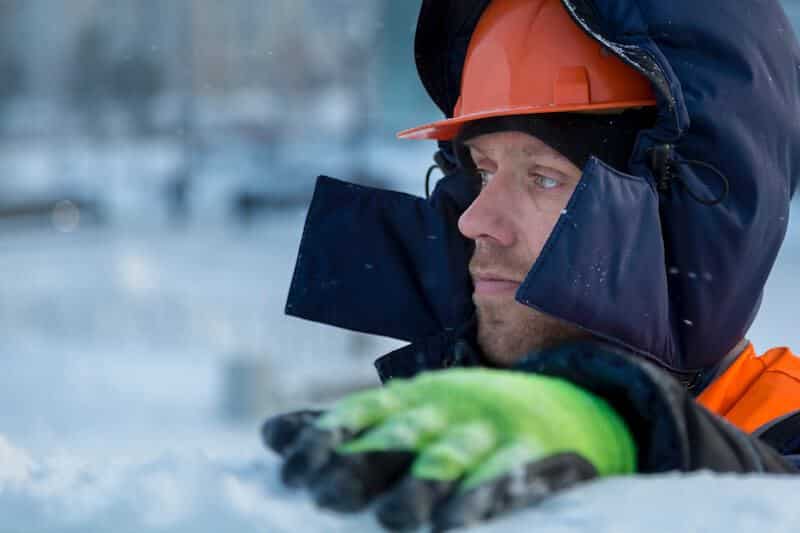
Hypothermia and Effects On Seafarers – What You Must Know
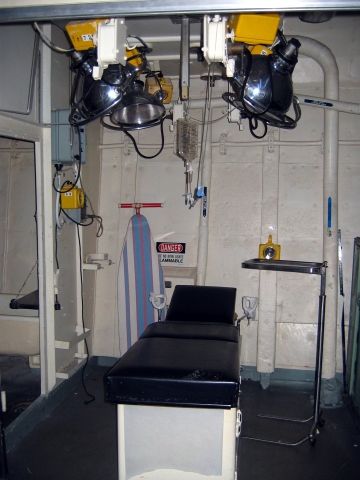
What is Sick Bay On Ships?
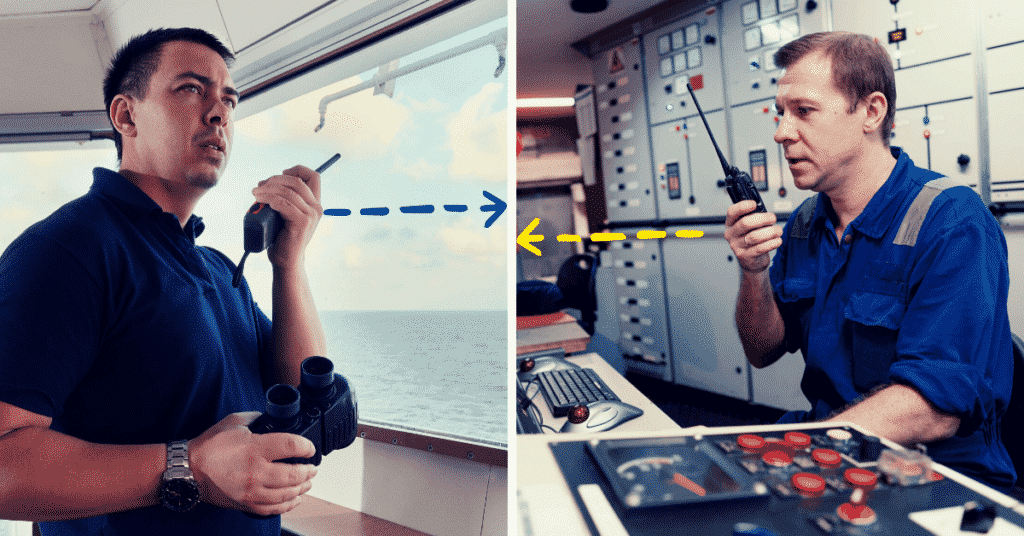
10 Situations Wherein Engine and Deck Officers Must Maintain Efficient Communication
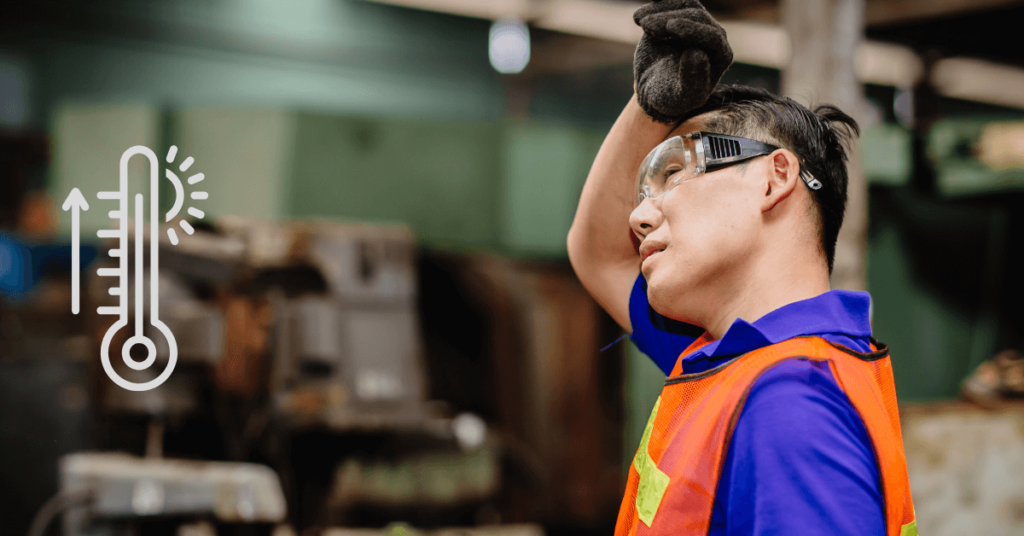
Hazards of Working in Extreme Heat on Ships

BE THE FIRST TO COMMENT
19 comments.
How many life rafts are there on ships and how many are sold each year? Any idea? Kind regards Chris
As stated in the article, the number depends on the size of the ship. You can refer regulation under SOLAS III/31.1.1.2.
What is the standard lenghth of an operating cord in an inflatable life raft?
Can you please provide the reference material used for the Basic Construction Details of Life Rafts section.
IS THERE A RELATION OR A RULES FOR POSITIONING OF DAVIT LIFE RAFT IN RELATION WITH THE POSITION OF FREE FALL LIFEBOAT
What if a liferaft failts to inflate or open? What action to be taken in that case sir ?
Can you tell me what is the minimum length of the ship which requires laftraft in forward sir maam?..pls rply thanks.
Hello, I’d like to know about that quantity of water and food ration. In the article says “Water ration- 1.5 litres of fresh water for each person”. This is a daily amount info? Appreciated Alex
It is allowed to put Ship’s name and Port of Registry to our inflatable Life rafts in the vessel?
Best Regards, Oliver
Remote liferafts asper SOLAS Ch III Regulation 31
1.4 Cargo ships where the horizontal distance from the extreme end of the stem or stern of the ship to the nearest end of the closest survival craft is more than 100 m shall carry, in addition to the liferafts required by paragraphs 1.1.2 and 1.2.2, a liferaft stowed as far forward or aft, or one as far forward and another as far aft, as is reasonable and practicable. Such liferaft or liferafts may be securely fastened so as to permit manual release and need not be of the type which can be launched from an approved launching device.
So for remote liferafts:- • HRUs are not required. • Must have means of rapid, easy manual release, while being secured against sea damage. • Must have sufficient means of embarkation (a knotted lifeline is not acceptable).
These lifeboats shall be of at least for 6 persons capacity since no liferaft shall have a capacity less than 6 people.
What is the standard size of a Painter line for a rigid life raft?
A good video, but @3:30 an inflated liferaft does not become “more heavier”, it becomes more buoyant
Than you Ian for the clarification. ??
How many types of liferaft
Life raft hose assembly, non-metallic for our 20 and 10 man life rafts, we use compressed air to fill our tanks and was wondering what the end fittings should be made of….should it be stainless steel , nickel, or brass.
Good Day My name is Charles Merritt and I will like to order life. Kindly email back with the cost of Revere Coastal Elite Life Raft and we can proceed from there. Thank you
Is it possible that a rocket parachute or hand flare of survival pack burst operate itself
It is unlikely for a rocket parachute or hand flare of survival pack to operate on its own without being activated.
Leave a Reply
Your email address will not be published. Required fields are marked *
Subscribe to Marine Insight Daily Newsletter
" * " indicates required fields
Marine Engineering
Marine Engine Air Compressor Marine Boiler Oily Water Separator Marine Electrical Ship Generator Ship Stabilizer
Nautical Science
Mooring Bridge Watchkeeping Ship Manoeuvring Nautical Charts Anchoring Nautical Equipment Shipboard Guidelines
Explore
Free Maritime eBooks Premium Maritime eBooks Marine Safety Financial Planning Marine Careers Maritime Law Ship Dry Dock
Shipping News Maritime Reports Videos Maritime Piracy Offshore Safety Of Life At Sea (SOLAS) MARPOL

- USCG/SOLAS Liferafts
- USCG Coastal Liferafts
- Inflatable Buoyant Apparatus (IBA)
- Commercial Liferaft Accessories
- Recreational Liferaft Accessories
- Aviation Liferafts
- In-Stock Liferafts
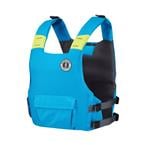
- Foam Type I, Type II, Type III
- Youth/Child/Infant Life Jackets
- Pet Flotation
- Float Coats
- Life Jacket Accessories
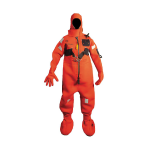
- USCG Approved
- USCG/SOLAS/TC Approved
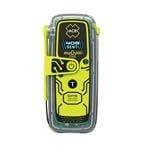
- AIS (Automatic Identification System)
- Local / Bluetooth
- Satellite Phones
- Satellite Messengers
- Lights & Strobes
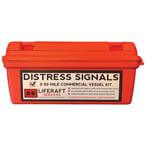
- Pyrotechnic
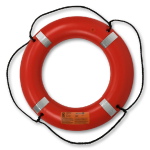
- Life Rings & Type IV Throwables
- Life Slings
- MOB Recovery Devices
- Marine First Aid Kits and Supplies
- Prep & Survival Accessories
- Active Wear
- Waterproof Boating Bags and Storage Packs
- Accessories
- Inflatable Boat Repair Kits (DIY)
- Extinguishers
- Ditch Bag Packages (Abandon Ship Kits)
- Ditch Bag Electronics
- Ditch Bag Signaling
- Ditch Bag Rations & First Aid
- Ditch Bag Accessories
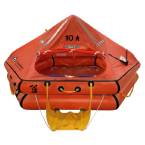
- Liferaft Sale
- Life Jacket Sale
- Signal Flare Sale
- Survival Suit Sale
- Apparel Sale
- Inflatable Boat Sale
- Manufacturer Rebates
- Coupon Codes
- Pre-Owned Liferafts
- Gifts Under $100
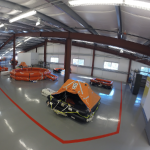
- EPIRB & PLB Battery Replacement Service
- Liferaft Inspection & Repack
- Immersion & Ice Suit Inspection
- Inflatable PFD Inspection
- Inflatable Boat Repair
- Partner Locations

- Commercial Liferafts
- ISO Approved Liferafts
Recreational Liferafts
- Valise vs. Container
- Emergency Pack Essentials
- Liferaft Servicing
- Life Jacket Fitting Guide
- Flares & Signaling Devices
- Commercial Fishing Regulations
- Life Raft Buyer's Guide
FREE Shipping over $149 (excludes liferafts, flares & oversize items)

Find Your New Liferaft:
Offshore Life Rafts - Recreational & ISO
These Offshore recreational life rafts are a good option for any non-commercial boater or sailor who is travelling miles offshore and looking to stay safe in case of emergency. Some of these ISO-9650 life rafts also meet standards for some sailboat and yacht racing associations. Each of these offshore rafts include an offshore equipment pack essential for survival until rescue is achieved.
- Available to Order
- Out of Stock
- Sailing / Yachting
- Boating / Fishing
- Recreational
- Ocean Safety
- Low Profile Container (LPC)
- Offshore (Recreational)
- 50 miles - SOLAS B
- > 24 hr ISO
- Recreational Offshore
Marine Safety Resource Center
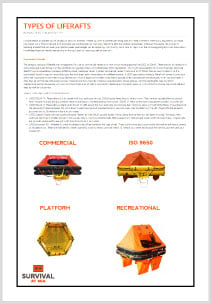
Emergency Beacons
Sign up for Special Offers and our Boating Safety Newsletter

Customer Service
- Order Status
- Gift Certificates
- Price Guarantee
- Terms and Conditions
Service Department
- Liferaft Inspection & Repack Request
- Immersion & Ice Suit Inspection Request
- Inflatable PFD Inspection Request
Simple & Secure Payment
Connect Wallet
select a wallet below
Sign up for Universal Rewards
Use your Loyal Points where you shop.

Ex-Display & Sample Sale
- Search for:
No products in the basket.
- Base Layers
- Technical T-Shirts
- Sailing Jackets
- Sailing Trousers
- Dinghy Footwear
- Sweatshirts
- Holebrook Samples
- Pelle Samples
- Changing Robes
- Cleaners & Proofers
- Scarves / Snood
- Dinghy Equipment
- Hi-fits / Trousers
- Hiking Equipment
- Hiking Shorts
- Spray Tops / Smocks
- Full Wetsuits
- Shorty Wetsuits
- Long John Wetsuits
- Wetsuit Tops
- Wetsuit Shorts & Trousers
- Summer Wetsuits
- Winter Wetsuits
- Children’s Wetsuits
- Men’s Wetsuits
- Women's Wetsuits
- Wetsuit Sale
- Technical Clothing
- Casual Clothing
- Hats, Gloves, Socks & Scarves
- Watersports
- Accessories Sale
- Amazing Bundle Deals
- Cables & Accessories
- Fixed GPS/plotters
- GPS Antennas
- Handheld GPS/Plotters
- Marine Cameras
- Mounting/Brackets
- Radar Scanners
- Sailing Watches
- Thermal Cameras
- Waterproof Cases
- Accessories
- Fish Finder Sonar
- Depth Instruments
- Multifunction Systems
- Speed Instruments
- Weather Instruments
- Wind Instruments
- Autopilot Accessories
- Cockpit Autopilots
- Onboard Autopilots
- Navigation Charts
- Plotting Aids
- Entertainment Accessories
- Entertainment Systems
- Speakers & Subs
- Electronics
- 4G and WIFI
- Handheld VHF Radio
- Mounted VHF Radio
- VHF Antennas
- Walkie Talkies
- Buoyancy Aids
- Lifejackets
- Children’s Life Jackets
- Commercial Lifejackets
- Harnesses/Bosuns Chair
- Lifejacket Accessories
- Safety Knives
- Safety Lights
- Safety Lines
- PLB & AIS
- Satellite Communicators
- Fire Safety Stick
- Fire Extinguishers
- GPS Tracker
- Liferaft Accessories
- Recovery Devices
- Survival Suit
- Cones & Balls
- Dye Markers
- Horns & Whistles
- RADAR Reflectors
- Bungs & Bailers
- Battery Management
- Chargers & Alternators
- Electrical Other
- Leisure Batteries
- Plugs & Connectors
- Shore Power
- Wind Generator
- USB & Phone Chargers
- Blocks & Terminals
- Circuit Breakers
- Seals / Outlets / Plugs
- Switches & Panels
- Wires & Cables
- Deck Lights
- Interior Lighting
- Navigation Lights
- Searchlights
- Head Torches
- Freshwater Pumps
- Macerator Pumps
- Service Kits
- Toilets/Waste
- Spray Guns & Connectors
- Toilet Accessories
- Toilet Parts
- Waste Tanks
- Ball Valves
- Inlet & Skin Fittings
- Metal Plumbing Fittings
- Plastic Plumbing Fittings
- Diverter Valves
- Non Return Valves
- Deionised Water
- Filters & Purification
- Taps & Sinks
- Water Heaters
- Water Tanks
- Gas Connectors
- Gas Fittings
- Bow Thruster
- Bungs And Self Bailers
- Cleats and Fairleads
- Deck Filler
- Deck Flooring & Protection
- Eye Bolts & U Bolts
- Grab Rail / Handles
- Hooks and Clips
- Latches & Catches
- Shackles & Swivels
- Tiller Extenders & Joints
- Track & Cars
- Winch Handles
- Fans & Windscoops
- Hatch & Inspection Covers
- Hatch Shades
- Hatches & Portlights
- Plastic Hatches
- Yacht / Keelboat Rope
- Dinghy Rope
- Dockline / Mooring Rope
- General Purpose Rope
- Watersports Rope
- Fender Rope
- Rope Accessories
- Furling & Reefing
- Mast, Spars & Sails
- Pins & Rings
- Rigging Screws, Adjusters & Tensioners
- Splicing & Whipping
- Thimbles & Stoppers
- Galvanising Paints
- Thinners & Solvents
- Paint Brushes
- Glue & Adhesives
- Mixing Pots & Accessories
- Resins & Epoxy
- Sealants & Caulking
- Boat Cleaner
- Cleaning Equipment
- Fabric Cleaners & Proofers
- General Cleaners
- Metal Cleaners
- Onboard Cleaner
- Polishes & Waxes
- Vinyl Cleaner
- Teak Cleaner
- All Zinc Anodes
- Zinc Shaft / Prop
- Zinc Engine / Outdrive
- All Aluminium Anodes
- Aluminium Hull
- Aluminium Shaft / Prop
- Aluminium Engine / Outdrive
- All Magnesium Anodes
- Magnesium Hull
- Magnesium Shaft / Prop
- Magnesium Engine / Outdrive
- Bow Thruster Anodes
- Hanging Anodes
- Bolts & Fixings
- Backing Pads
- Lubricants & Grease
- Power Tools
- Marine Prepacks
- Dehumidifiers
- Blowers & Exhaust
- Engine Oil & Additives
- Oil Extractors & Filters
- Shaft Bearings
- Pumps & Inflation
- Tender Accessories
- Petrol Engines
- Boat Fender
- Dock Fender
- Edging Strip
- Hooks & Pumps
- Mooring Buoy
- Step Fenders
- Anchor Bags
- Anchor Connectors
- Anchor Lines
- Anchor Windlass
- Compensators
- Personal Craft
- Engine Covers
- Fuel Tanks & Lines
- Fuel Connectors
- Kill Switches
- Propeller Bags
- Straps & Ratchets
- Flag Staff & Holder
- Lighters & Matches
- Cabinet Fridges
- Cooling Kits
- Portable Fridge/freezers
- Chandlery Misc
- Cup Holders
- Sail Knives
- Seats & Cushions
- Games & Toys
- Gift Vouchers
- Nautical Gifts
- Novelty Hats
- Anemometers
- Clocks & Barometers
- Teak Fittings
- Weather Stations
- Galley Equipment
- Tumblers & Glasses
- Water Bottles & Flask
- Inflatable Paddleboards
- Hard Paddleboards
- Inflatable Kayaks
- Handles / Bridles
- Throw Lines
- Swim Accessories
- Sea Scooter
- Free Delivery on UK mainland orders over £100 excl. Highlands / rural areas
Order with next working day delivery before 3PM Thursday 22nd August for delivery before the weekend. (When in stock and sent to UK mainland* click HERE for more information).
Port Solent Store / Click & Collect - Open as usual throughout the weekend and bank holiday Monday See opening times HERE
Order with next working day delivery before 3PM Thursday 22nd August for delivery before the weekend. (UK mainland* click HERE for more information). Port Solent store and click & collect open as usual
Expect the unexpected by always having a life raft onboard. Fires, collisions and rogue waves can afflict even the most accomplished sailors. We have carefully selected our range of life rafts, offering both valise and canister in 4, 6, 8 and 12-man size. Premium brands such as Seago, Ocean Safety and Crewsaver are leading experts in the construction of survival rafts fit for ocean and coastal situations. To help with your safety in emergency situations, ensure that you are equipped with the latest life raft accessories .
Showing all 6 results
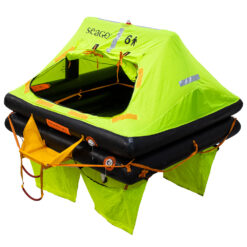
Seago Sea Cruiser Plus ISO 9650-1 Type 2 Liferafts
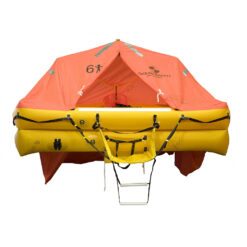
Ocean Safety Ocean ISO Liferafts

Ocean Safety Ocean Standard Liferafts
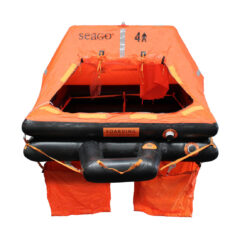
Seago Sea Master Liferafts ISO 9650-1
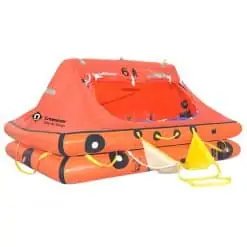
Crewsaver ISO Ocean Liferafts

Ocean Safety Regatta Liferaft ISO9650
Username or email address *
Password *
Remember me Log in
Lost your password?
Email address *
A password will be sent to your email address.
Choosing the right life raft for your boat
Ensure the safety of your family and crew while sailing by choosing the right life raft for your boat - read our comprehensive guide to learn about the factors to consider and make an informed decision.
Choosing the Right Life Raft for Your Boat
As you embark on your sailing adventure, leaving the rat race behind and embracing the open sea, the safety of your family and crew should be your top priority. One of the most critical pieces of safety equipment on any boat is the life raft. In this comprehensive guide, we will explore the various factors to consider when choosing the right life raft for your boat, ensuring that you are well-prepared for any emergency situation that may arise.
Table of Contents
Why you need a life raft, types of life rafts, capacity and size, life raft features, storage and deployment, maintenance and inspection.
While we all hope to never find ourselves in a situation where we need to abandon ship, the reality is that accidents and emergencies can happen at any time. A life raft serves as your last line of defense in the event of a catastrophic event, such as a fire, collision, or sinking. It provides a temporary shelter and survival platform for you and your crew, increasing your chances of being rescued.
In addition to being a crucial safety measure, having a life raft on board may also be a legal requirement, depending on the size of your boat and the waters you plan to sail in. Many countries and sailing organizations have specific regulations regarding life rafts, so it’s essential to familiarize yourself with these requirements before setting sail.
There are several types of life rafts available on the market, each designed for different types of vessels and sailing conditions. The main categories of life rafts include:
Coastal Life Rafts
Coastal life rafts are designed for use in relatively sheltered waters, close to shore. They are typically lighter and more compact than offshore life rafts, making them suitable for smaller boats with limited storage space. However, they may not be as durable or well-equipped as their offshore counterparts, and they may not meet the requirements for boats sailing in more challenging conditions.
Offshore Life Rafts
Offshore life rafts are built to withstand the harsh conditions of open ocean sailing. They are generally more robust and better equipped than coastal life rafts, with features such as insulated floors, heavy-duty canopies, and more extensive survival equipment. These life rafts are suitable for boats that venture far from shore and may be required for boats participating in offshore races or cruising in remote areas.
ISO 9650 Life Rafts
The International Organization for Standardization (ISO) has developed a set of standards for life rafts, known as ISO 9650. These life rafts are designed to meet specific performance criteria and are subject to rigorous testing and certification. ISO 9650 life rafts are available in two types: Type 1 for ocean use and Type 2 for coastal use. Choosing an ISO 9650 life raft ensures that you are getting a high-quality, reliable product that meets international safety standards.
When selecting a life raft, it’s essential to consider the number of people it needs to accommodate. Life rafts are available in various capacities, typically ranging from 4 to 12 persons. It’s crucial to choose a life raft with a capacity that matches or exceeds the number of people on board your boat.
Keep in mind that the stated capacity of a life raft refers to the number of people it can accommodate in an emergency situation, not necessarily in comfort. In a real-life scenario, you may need to accommodate injured crew members or additional supplies, so it’s a good idea to choose a life raft with a slightly higher capacity than the number of people on board.
In addition to capacity, consider the size and weight of the life raft. Smaller boats may have limited storage space, so it’s essential to choose a life raft that can be easily stowed and deployed. Some life rafts are available in compact, lightweight models designed specifically for smaller vessels.
Life rafts come with various features designed to enhance their performance and survivability in emergency situations. Some key features to look for when choosing a life raft include:
Canopy: A canopy provides protection from the elements and helps to maintain body heat. Look for a life raft with a high-visibility canopy that is easy to erect and has adequate ventilation.
Insulated Floor: An insulated floor helps to protect occupants from cold water and provides additional buoyancy. This feature is particularly important for life rafts intended for use in cold water environments.
Ballast Bags: Ballast bags are weighted compartments that fill with water, helping to stabilize the life raft and prevent it from capsizing in rough seas. The more ballast bags a life raft has, the more stable it will be.
Boarding Ladder: A boarding ladder or ramp makes it easier for occupants to enter the life raft from the water, particularly in rough conditions or when wearing bulky survival gear.
Survival Equipment: Life rafts should come equipped with essential survival equipment, such as flares, signaling devices, a first aid kit, and water and food rations. Some life rafts also include additional items like a sea anchor, fishing kit, or repair kit.
Proper storage and deployment of your life raft are critical to its effectiveness in an emergency. Life rafts are typically stored in either a hard container or a soft valise. Hard containers are more durable and provide better protection for the life raft, but they can be bulky and heavy. Soft valises are lighter and more compact, but they may not offer the same level of protection.
When choosing a storage location for your life raft, consider the following factors:
Accessibility: The life raft should be easily accessible from the deck and cockpit, even in rough conditions or when the boat is heeled over.
Protection: The life raft should be protected from damage caused by UV exposure, chafing, or impact.
Deployment: The life raft should be stored in a location that allows for quick and easy deployment in an emergency. Some life rafts are designed to be mounted on deck or in a dedicated storage locker, while others can be stored in a cockpit locker or below deck.
Regular maintenance and inspection are essential to ensure that your life raft remains in good working order. Most life raft manufacturers recommend that their products be serviced and inspected every three to five years, depending on the model and usage. This service typically includes a thorough inspection of the life raft’s fabric, seams, inflation system, and survival equipment, as well as any necessary repairs or replacements.
It’s also a good idea to familiarize yourself with your life raft’s operation and practice deploying it in a controlled environment. This will help to ensure that you are prepared to use the life raft effectively in an emergency situation.
Choosing the right life raft for your boat is a critical decision that can have a significant impact on the safety and well-being of your family and crew. By considering factors such as the type of life raft, capacity, features, storage, and maintenance, you can select a life raft that meets your specific needs and provides the best possible protection in an emergency situation. Remember, a life raft is an investment in your safety and peace of mind as you embark on your sailing adventure, so choose wisely and sail with confidence.
Yachting Monthly
- Digital edition

Where should you stow your liferaft?
- Chris Beeson
- September 12, 2016
Wherever you cruise, you’ll most likely want to keep a liferaft on board in case of emergency – but where’s the best place to stow it? Duncan Kent makes some suggestions

A little thought to where you stow your liferaft now could save lives later Credit: Graham Snook/YM

Duncan Kent
Liferafts are your last lifeline should the unthinkable happen, so it makes a lot of sense for them to be easily accessible in every eventuality. Of course you should only step up into a liferaft, but before you can do that you have to launch it, so a little thought now could save time or even lives if you ever need to use one in anger. Most new boats have a dedicated stowage space for a liferaft but is that necessarily the best place to keep it? It protects the liferaft very well but, if you have to fold down the transom to access it, it’s not an ideal location should your yacht be inverted.
Canister or valise?

A valise is usually cheaper, but offers less protection from the elements
When first purchasing a liferaft you need to make a couple of important decisions – how big should it be and what type of container should it have. The first is common sense and would obviously depend on the number of people you regularly cruise with. The second is more important as it partially dictates where you might stow it. A liferaft in a rigid GRP canister is designed to face the elements without getting damaged. A soft plastic valise, however, may be a little lighter, but it isn’t as tough or UV-proof and therefore should be stowed in a locker to protect it.
Do I need hydrostatic release?

A hydrostatic release unit will release your liferaft once it’s a few metres underwater
This is usually achieved by attaching the raft to its mount using straps and a hydrostatic release such as the Hammar H20. As with some automatic lifejackets, the device is activated by water pressure. When submerged in water to a depth of a few metres it cuts a loop of rope releasing the securing straps.
A regular quick release attachment, like a pelican clip for example, can be attached to the release loop so the user can release the liferaft manually if required. It’s questionable whether a hydrostatic release is ideal for a leisure yacht, though. In theory they should only release at a depth of two metres of water – as your yacht is sinking beneath you, fingers crossed your liferaft will float free. But what would happen during a knockdown? Will it activate and release your liferaft before you really need it?
It might be useful if you had a second, backup raft (unlikely on a small boat), but I’d prefer to be in control of the timing of liferaft deployment. Like all safety equipment it might save your life, but whether you need one is a question only you can answer after looking at your liferaft installation.
PROS Automatically launches in the event of the yacht sinking
CONS Doesn’t release until submerged to a depth of a few metres Needs replacing every two years
Possible areas to stow your liferaft

Let’s examine the liferaft stowage possibilities
On the deck. Easier to launch, can be fitted with a float-free device but susceptible to the elements and tempting to thieves
In a cockpit locker. Safe from theft, provided you padlock your lockers, but could become buried beneath cruising paraphernalia
On the pushpit rail. Easy to launch, reasonably secure from theft but takes up valuable space and will be a heavy weight on the rail mountings
In/on the transom. Out of the crew’s way. Easy to launch – even from the water. Relatively protected and secure from theft. Possibly quite damp and not always accessible
Stowing down below. Dry, out of the sun and secure from theft, but also difficult to get to in a hurry. A liferaft will be heavy to lift up the companionway
Why you shouldn’t stow it down below

Liferafts are usually large and heavy so unless you always sail with two strapping crew they are best stowed somewhere more accessible
There’s absolutely no point in buying a safety device if you can’t get to it in an emergency. I regularly go on boats where the flares are buried beneath a pile of stuff in a locker below, and where the liferaft is at the bottom of a deep cockpit locker with the dinghy, barbeque, spare fenders, buckets, kedge anchor and more all piled on top. The owners always say they’re about to do something about it, but they rarely ever do!
There are two very good reasons for not stowing a liferaft below. The first is: it’s heavy and you’d have to be fairly big and strong to heft it up the companionway and over the bridgedeck. It’s all my petite wife can do to lift our four-man valise off the ground, let alone drag it up steep companionway steps.
Second, you might have to evacuate in a hurry in the event of a fire and grabbing the liferaft will probably be the last thing you think about until you get on deck and start wondering how you’re going to get off. By then it’ll likely be too late.
In the opinion of the RNLI and the RYA a liferaft should always be mounted where it can be deployed instantly and effortlessly by any member of the crew. I can’t help but entirely agree with that logic, so let’s give some thought to how best we can mount one on deck to attain that goal.
PROS Dry and out of the sun Secure from theft
CONS Difficult to get to in a hurry Heavy to lift up the companionway
Stowing a liferaft canister on the deck

A Rustler 37 with solidly mounted canister
Mounting a canister in wooden chocks on the hatch garage is probably the most popular place to stow a liferaft on a small to medium size sailing yacht and has a lot going for it. Firstly it’s quite high up, so it doesn’t take that much to drag it down and lob it over the guardrail.

A Vancouver 34 with a cover over the liferaft so it’s less vulnerable to the elements and theft
It is, however, one of the most exposed places on the yacht and susceptible to damage from the sun’s UV rays, continuous spray, the odd big greenie and the crew’s hefty boots. It’s also heavy and, being so vulnerable, needs to be very solidly mounted. It is essential to check the strength of the garage first, as not all are substantial enough to support the weight of a liferaft. If there’s any flex in it, try to find space on the deck itself.
Fixing it here also puts quite a bit of extra weight up relatively high on the boat, although not really enough to concern a cruising skipper. Care must also be taken to avoid the possibility of it snagging any loose sheets or lines, so you might need to create a cage around it to deflect them or re-route some of them via strategically-placed turning blocks.
When you’ve secured it make a canvas cover to keep off the worst of the sun and spray. The cover may need replacing every 3-4 years, but at least the raft will be fairly well protected.
PROS Easier to launch Can be fitted with float-free device
CONS Susceptible to the elements Tempting to thieves
Stowing a liferaft valise in a cockpit locker

GOOD: A dedicated safety locker with all you need to abandon ship
Many smaller cruising yachts will have little or no room on their transom or stern rail, and possibly little space on deck forward of the main hatch. In these cases it might well be necessary to stow the liferaft in a cockpit locker and as a canister is usually much bulkier than a valise, you will probably choose the latter.

BAD: How long would it take to dig out this liferaft?
To get over the accessibility problem it makes sense either to dedicate the entire locker to the liferaft, grab bag and flare container, or to fabricate a lid-less ‘emergency’ bin (with a drain hole) to contain the above. To avoid the risk of other stuff being piled on top make sure it comes right up to the locker lid so that there’s physically no room to put anything on it. At worst, create a stout, drained and deeply-fiddled shelf to put the raft on, but don’t tie the container down in any way.
Oh, and don’t forget to fix a stout padeye at the top onto which to tie the painter or someone might forget before they lob it over. You can always tie it in a more convenient position once the liferaft’s in the water.
PROS Dry and protected from physical damage and UV light More secure from theft
CONS Not so easy to access quickly Tends to have stuff dumped on top
A pushpit-mounted canister

Launching this liferaft is a matter of pulling out a lockable pin and letting the canister fall
My personal preference, if you have the space, is to construct or buy a proper stainless steel cradle that fixes on the yacht’s stern rail. This keeps it out of the crew’s way when sailing, but makes it very accessible when required in a hurry. In fact, with a little ingenuity it could even be designed so it could be launched from the water, which is ideal for the single-hander (along with a long floating line to disconnect the autopilot of course!).

With the painter tied on, this liferaft canister has a clear, damage-free drop into the water
The main advantage of a rail-mount is that it is easy for anyone, regardless of their brawn, or lack of it, to deploy. For this reason it should be designed so that simply pulling a safety pin opens the cage and allows the canister to fall into the water unaided and without being damaged on the way down.
A secondary plus for this method is that the cage can be securely locked when not under way, but always remember to unlock it before every trip.
Easy to launch – possibly from the water
Reasonably secure from theft
Takes up valuable space
Heavy weight on the rail mountings
Stowing a canister in or on the transom

The raft on the RM890 is easily accessible and close to the water, but it’s also exposed
A large number of cruising yachts built in the 1980-90s had a sugar scoop-style transom. Not only does this make boarding easier from the water but, with a bit of thought, it can be an ideal place to stow the liferaft. You can either fit a cradle in a similar way as a pushpit mount, or you can fabricate a locker of sorts.

On this Hanse 415, reaching the liferaft from the water means dropping the transom
The downside of using a cage this position is its proximity to the water, which, when you have a big following sea, can frequently inundate the raft. Better to build a watertight locker, but put a drain into it just in case.

An excellent locker onboard the Winner 12.20 means the liferaft is protected but can also be launched in seconds
Although it’s easy to deploy a raft from here when you’re standing on the scoop or step, bear in mind it might be stormy when you need it and the scoop is not always the best place to be in a rough sea.

Even if your yacht doesn’t have dedicated transom stowage, there is nothing to stop you making your own
I have seen yachts with modified transom, whereby a dedicated locker is made to fit inside the stern, but this is dependent on whether you have a usable void inside the aft end of the boat. It also requires a bit of thought and GRP construction skills, but if it is designed with a gentle aft-running slope the raft can self-deploy as soon as the door is opened. Once again you’ll need to ensure the painter is firmly tied off at all times.
Out of the crew’s way
Easy to launch – even from the water
Relatively protected and secure from theft
Possibly quite damp
Not always accessible

Six ISO 9650 liferafts tested
Do manufacturers abide by the self-regulating ISO 9650 liferaft standard? Does the standard go far enough? Chris Beeson tests six…

Life in a liferaft
Ever wondered what life in a liferaft is really like in rough weather? Yachting Monthly's Chris Beeson packed his sick…
MORE SECTIONS
- Dear Deidre
MORE FROM THE SUN
- Newsletters
- Deliver my newspaper
- Sun Vouchers
- The Sun Digital Newspaper
- Racing Members Enclosure
- Fabulous Clothing

Pics show tiny life raft that saved Bayesian survivors including baby as they crammed on screaming as yacht sank
- Ellie Doughty , Foreign News Reporter
- Published : 12:45, 20 Aug 2024
- Updated : 13:55, 20 Aug 2024
- Published : Invalid Date,
NEW pictures show the tiny life raft that saved 11 people after the Bayesian superyacht sank in Italy on Monday.
The £14million luxury vessel plunged more than 160ft to the bottom of the sea after it was toppled by extreme weather at around 5am on Monday.

The mast collapsed when it was hit by heavy storms and a tornado , causing the boat to capsize off the coast of Palermo, with four Brits and two Americans still yet to be found.
Fifteen people were rescued in total , with most of them clinging to the small orange life-raft as they were pulled from the water.
The yacht's chef, Ricardo Thomas, was confirmed dead after rescuers found his body near the wreck on Monday.
UK billionaire tycoon Mike Lynch, 59, and his daughter Hannah, 18, are among the missing but his wife Angela Bacares, 57, was saved .
READ MORE ON YACHT TRAGEDY

Wife of Brit tycoon woken by 'tilting' yacht & walked on glass to escape

Fears grow for superyacht victims as divers ‘reach yacht’s lounge’
British tourist Charlotte Golunski, 35, was also rescued with her one-year-old baby from the doomed yacht .
She managed to grab hold of young Sophia as the pair were forced into the Mediterranean amid rough weather and choppy waters.
It comes as...
- 'UK's Bill Gates' Mike Lynch & his daughter Hannah, 18, remain missing on the wreck
- Also missing are Jonathan Bloomer , Judy Bloomer, Chris Morvillo and Neda Morvillo
- Lynch's wife revealed how she was awoken by a 'tilt' as the yacht sunk
- The captain of the Bayesian broke his silence on the horror storm
- Experts believe the yacht's ' tallest mast in the world ' may have contributed to the disaster
- Frantic text messages from the survivors revealed the chaos
Most read in The Sun

Beloved BBC star who appeared in Dad's Army dies as emotional tributes pour in

Kaoru Mitoma currently most transferred-in player ahead of Gameweek 2

70s rock legend, 68, rushed to hospital & reveals he's been forced to quit tour

International chairman of bank giant Morgan Stanley, Brit Jonathan Bloomer , 70, is one of the six feared dead along with his wife Judy.
And top New York lawyer Chris Morvillo, a solicitor at major firm Clifford Chance who worked for Mike Lynch, and his wife Neda, were also lost at sea.
The search for those feared dead entered its second day today with dramatic footage showing firefighters and divers scouring the water.
Specialist divers have been deployed from the UK government's Marine Accident Investigation Branch to help.
Although the 184ft yacht is lying "practically intact" on its side at the bottom of the sea, rescuers have been struggling to get into it.
Diver Marco Tilotta said there was a "world of objects" including furniture and debris obstructing the narrow stairs in front of the yacht cabins.
He said of the missing on Tuesday morning: "We will do everything we can to recover the bodies.
"The weather conditions are worsening but we hope to continue the operations without problems".
A shell-shocked Angela told Italian outlet La Repubblica that she and her husband woke up at around 4am on Monday to a sudden shift onboard the superyacht.
The mum, who suffered horrific injuries to both feet, told the Italian outlet of the "slight tilt" she felt before tragedy struck.
She reportedly told Corriere that "everything was falling" around her and she was almost "carried away" before she managed to escape to safety.
Her husband Lynch, previously dubbed "the British Bill Gates", was hosting a party on the boat.
The business tycoon - worth an estimated £852million - was surrounded by members of his legal firm and company Invoke Capital to celebrate a US jury clearing him of fraud earlier this summer.
He was extradited to the US in 2023 over the £8.5billion sale of his software firm Autonomy to Hewlett-Packard in 2011 and was accused of inflating the company’s value.
READ MORE SUN STORIES

Thousands of households can get up to £500 in free cash or supermarket vouchers

Love Is Blind UK fans only just realising where they’ve seen Catherine on before
The dad-of-two had spent a year under house arrest in the States.
He was cleared of 16 counts of wire fraud, securities fraud and conspiracy, following a trial in San Francisco in June.

- Bayesian yacht sinks
- Weather - Latest forecast for the UK
Watch CBS News
Luxury yacht sinks off Sicily, leaving U.K. tech magnate Mike Lynch, 2 Americans among those missing
By Anna Matranga
Updated on: August 20, 2024 / 5:56 AM EDT / CBS News
Rome — Six people, including two U.S. nationals, a British technology entrepreneur and one of his daughters, were still missing Tuesday after a large luxury sailing yacht sank off the coast of the southern Italian island of Sicily during a violent storm. The 184-foot Bayesian had been anchored about half a mile off the port of Porticello, near Palermo, with 22 people on board — 10 crew members and 12 passengers.
The vessel sank at about 5 a.m. local time (11 p.m. Eastern, Sunday) after being hit by a possible waterspout spawned by the storm. Italian media said the winds snapped the boat's single mast, unbalancing the vessel and causing it to capsize.
Fifteen of those on board managed to escape the yacht and were rescued by a Dutch-flagged vessel that was anchored in the immediate vicinity. They were brought ashore by Italian Coast Guard and firefighters.

One body — an unidentified male — was recovered, but six people remained missing, including British software magnate Mike Lynch, once described as Britain's Bill Gates.
Lynch was acquitted in June of fraud charges in the U.S. that could have landed him with a decades-long prison sentence. In an unusual twist, Lynch's co-defendant in that fraud case, who was also acquitted, died Saturday after being hit by a car while out jogging in England.
Lynch's teenage daughter Hannah was also among those missing, along with Lynch's American lawyer Chris Morvillo, a former assistant district attorney in New York, and his wife Neda. British banker Jonathan Bloomer, chairman of Morgan Stanley International, was also still missing Tuesday.

Among the survivors was a 1-year-old British girl who was being treated at a nearby hospital along with her parents. They were doing well, according to Italian media.
"For two seconds I lost my child to the sea, then I immediately was able to grab her again in the fury of the waves," the girl's mother, identified only as Charlotte, was quoted as saying by Italy's ANSA news agency. "I held on to her tightly in the stormy sea. Many were screaming. Luckily the life raft opened up and 11 of us managed to get aboard."
"It was terrible," she told ANSA. "In just a few minutes the boat was hit by a very strong wind, and sunk soon thereafter."
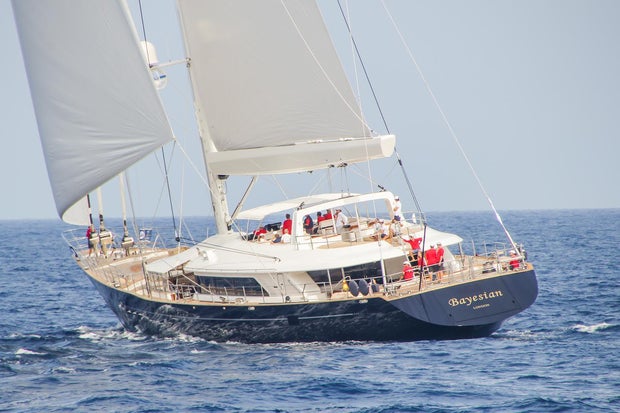
Karsten Borner, the captain of the Dutch vessel that came to the rescue, told ANSA he had been anchored near the Bayesian.
"When the storm was over we noticed that the ship behind us was gone, and then we saw a red flare, so my first mate and I went to the position and we found this life raft drifting, and in the life raft was also a little baby and the wife of the owner."
Recovery efforts were back underway Tuesday, with speedboats, helicopters and divers continuing to search for the missing — as well as for answers, as to how a state-of-the-art superyacht could disappear in a flash.
According to Italian media, Fire Brigade divers reached the boat and saw bodies trapped inside some of the cabins, but they had been unable to recover any of the victims from inside the vessel by Tuesday, due to obstructions. The Bayesian appeared to have sunk in an area with a depth of about 160 feet.

Witnesses said the boat sank quickly.
"I was at home when the tornado hit," fisherman Pietro Asciutto told a local news outlet. "I immediately closed all the windows. Then I saw the boat, it had only one mast, it was very large. I suddenly saw it sink... The boat was still floating, then suddenly it disappeared. I saw it sink with my own eyes."
The director-general of Sicily's civil protection agency, Salvatore Cocina, confirmed to CBS News partner BBC News that three of the six people still missing Monday were British tech entrepreneur Mike Lynch, whose company Autonomy Corporation PLC was acquired in 2011 by HP ; one of his daughters, Hannah Lynch, who is believed to be 18; and the boat's chef, Ricardo Thomas.
CBS News has seen corporate documentation showing a company called Revtom, solely owned by Lynch's wife Angela Bacares, who was among those rescued from the accident, as the owner of the yacht that capsized off Sicily.
While the yacht was a privately owned pleasure boat, the waters around the island have claimed many lives over the last decade.
Dozens of migrants have died attempting to reach Sicily and smaller Italian islands in the region. Sicily sits only about 100 miles from the east coast of Tunisia in north Africa, and the Mediterranean crossing has been a frequent site of both nautical rescues and disasters as smugglers routinely send small boats overloaded with desperate people into the sea.
CBS News' Chris Livesay in Rome and Joanne Stocker in London contributed to this report.
Joanne Stocker and Alex Sundby contributed to this report.
- Boat Accident
More from CBS News

Man, 37, dies in drowning at Folsom Lake near Granite Bay boat ramp

Tesla semi-truck fire on Northern California freeway leaves people stranded for hours

Search on for man missing in Emigrant Wilderness after his dog is found alone

San Joaquin County supervisors deny election advisory committee's push for fewer ballot boxes
- Search Please fill out this field.
- Manage Your Subscription
- Give a Gift Subscription
- Newsletters
- Sweepstakes
:max_bytes(150000):strip_icc():format(webp)/Kyle-Marisa-Roth09-04152024-e66fe1898d2b40f391dd55d3c5a62525.jpg)
- Human Interest
- Real People
Captain Who Saw Yacht Sink in Sicily and Helped Rescue Survivors Calls Incident a 'Big Disaster'
"We noticed that the ship behind us was gone,” Karsten Borner recalled after the storm was over
A boat captain in Sicily recalls saving several survivors just moments after a fatal yacht incident in Italy left at least one person dead and six people missing.
The Bayesian vessel, a 56-meter (183-ft) superyacht carrying 22 people, was anchored when a tornado formed over the water, known as a waterspout, striking the superyacht before it lost its balance and sank, per Sicilian news agency Ansa .
Karsten Borner, who was a captain on a nearby boat, saw the boat sink "a few minutes" after it was hit, he told Italian news outlet Rai, per the BBC .
"It all happened in really little time," he continued.
“The storm was over. We noticed that the ship behind us was gone,” Borner told the BBC in a video interview Monday. “And then we saw a red flare, so my first mate and I went to the position and we found this life raft drifting [with] 15 people inside."
Corpo Nazionale dei Vigili dei del Fuoco via Getty Images
According to Borner, four people were hurt, including three who sustained severe injuries.
“We brought them to our ship, and then we communicated with the Coast Guard. Then after some time, the Coast Guard came, and later they picked the injured people [up],” the captain of the nearby ship said.
Borner recalled using a light to see that the Bayesian was overturned. He noted that there was a “little baby” in the life raft, later identified as a 1-year-old English girl named Sophie .
"It was a big disaster," he concluded.
Never miss a story — sign up for PEOPLE's free daily newsletter to stay up-to-date on the best of what PEOPLE has to offer, from celebrity news to compelling human interest stories.
Vincenzo Pepe/Getty
The child was transported to the Children's Hospital of Palermoper Ansa, per Corriere Della Sera . Her mother was identified to PEOPLE by local authorities as Charlotte Golunski.
Golunski told the Italian newspaper la Repubblica she briefly lost Sophie due to the turbulent sea but later found her.
"I held her afloat with all my strength, my arms stretched upwards to keep her from drowning,” the mother told the newspaper.
She added, "It was all dark. In the water, I couldn't keep my eyes open. I screamed for help but all I could hear around me was the screams of others."
The baby’s father, James Emsley, survived the incident, an official with Sicily's civil protection agency told Sky News.
At the time the yacht sank, the Coast Guard said 12 passengers were on board as well as 10 crew members, per the Associated Press .
One person was found dead near the yacht and has since been identified as a cook from the boat, according to local outlet Palermo Today and the BBC .
Of the six who are still missing are British tech entrepreneur Mike Lynch and his daughter Hannah. His wife, Angela Bacares, was among those rescued, local sources said.
Simon Dawson/Bloomberg via Getty
Just months ago Lynch, the founder of the U.K.-based tech company Autonomy, was acquitted on all charges that alleged he inflated his company's earnings ahead of an $11 billion deal with Hewlett-Packard, per TechCrunch and the Associated Press .
In a statement shared with the outlets at the time, the tech giant said he was "looking forward to returning to the U.K. and getting back to what I love most: my family and innovating in my field.”
PEOPLE has reached out to the Italian Coast Guard for further comment, but they did not immediately respond.
Related Articles
British tech entrepreneur Mike Lynch missing after superyacht sinks in storm off coast of Sicily
Topic: Maritime Accidents and Incidents
Video released by Italian authorities show the stretch of sea near Palermo, Sicily, where the superyacht Bayesian sank. ( AP: via Vigili del Fuoco )
British tech entrepreneur Mike Lynch, his lawyer and four other people are missing after a superyacht carrying 22 people sank off the coast of Sicily, authorities say.
Fifteen people, including Mr Lynch's wife, have been rescued after the boat was hit by a violent storm at sunrise, according to the Italian Coast Guard.
What's next?
Divers had located the wreck 50 metres underwater and search operations are continuing.
British tech entrepreneur Mike Lynch, his lawyer and four other people are missing after a superyacht carrying 22 people capsized and sank off the coast of Sicily due to bad weather.
Mr Lynch's wife and 14 other people were rescued, including a one-year-old girl, and one person has died.
A person familiar with the rescue operation confirmed to Reuters that Mr Lynch's 18-year-old daughter Hannah has not been accounted for.
The British-flagged, 56-metre Bayesian had a crew of 10 people and 12 passengers, representing British, American and Canadian nationalities, the Italian Coast Guard said.
British tech entrepreneur Mike Lynch is reportedly among those missing. ( Reuters: Henry Nicholls )
Managers of the sailing yacht Bayesian, Camper & Nicholsons, confirmed to the ABC that the Bayesian encountered severe weather and subsequently sank near the Sicilian capital Palermo, Italy, at 4:30am Monday, local time.
"Our priority is assisting with the ongoing search and providing all necessary support to the rescued passengers and crew," they said.
Fifteen people were rescued and taken to shore at Porticello, where eight were receiving treatment in hospital and remain in a stable condition, the Italian Coast Guard said.
One body has been recovered and police divers were trying to reach the hull of the ship, which was resting at a depth of 50 meters where it had been anchored.
British Bill Gates missing
Mr Lynch is often dubbed by UK media as "the British Bill Gates" and the BBC confirmed the luxury yacht was tied to his wife, Angela Bacares.
According to maritime data service Equasis, the owner of the the Bayesian is listed as Revtom Ltd, the BBC reported.
Additionally, the yacht's name would resonate with Mr Lynch because his PhD thesis and the software that made his fortune was based on Bayesian theory.
Mr Lynch was acquitted in June by a jury in San Francisco of fraud charges linked to the sale of his software company, Autonomy, to Hewlett-Packard for $US11 billion ($16.4 billion) in 2011.
He said at the time that he was "elated" to be cleared in the criminal trial in which he denied any wrongdoing, and blamed HP for botching the integration of the two companies.
In a separate incident, Mr Lynch's co-defendant in the trial, Stephen Chamberlain, died on Monday after a road accident left him critically injured.
Mr Chamberlain — Autonomy's former vice-president of finance alongside Mr Lynch — had been placed on life support after being hit by a car in Cambridgeshire on Saturday morning.
Rescued baby held above waves
The coast guard said that rescue efforts had located the wreck at a depth of 50 metres underwater.
The Italian fire and rescue service agency said search operations at sea were continuing with the coordination of the Italian Coast Guard, in a translated post on the social media platform X.
One of the survivors, identified only as Charlotte, said she had momentarily lost hold of her 1-year-old daughter Sofia in the water, but then managed to hold her up over the waves until a lifeboat inflated and they were both pulled to safety, Italian news agency ANSA reported.
A spokesperson for the UK's Foreign, Commonwealth and Development Office said they were providing support to British nationals.
"We are providing consular support to a number of British nationals and their families following an incident in Sicily, and are in contact with the local authorities"
Captain of nearby boat helped rescue passengers
The captain of a nearby boat that helped to rescue passengers from the Bayesian said that when the storm hit he turned his engine on to keep control of the vessel and avoid a collision with the Bayesian.
"We managed to keep the ship in position and after the storm was over, we noticed that the ship behind us was gone," Karsten Borner told Reuters.
He said that his crew then found 15 survivors on a life raft, including three who were seriously injured and took them on board before the coast guard picked them up.
"There were 15 people inside," he said.
"Then we communicated with the Coast Guard and after some time, the Coast Guard came and later picked up injured people, and 2 hours later they picked up the other people."
Mr Borner said "a little baby and the wife of the owner" were among the survivors, while the owner of the sunken ship and another child were among those missing.
He described the conditions as "very strong" and said that his vessel was "heeling" but the Bayesian "went flat on the water and then down".
"There was a light and we saw that the ship was aside and then we saw a triangle," he said.
"So I think she went back down."
Storms and heavy rainfall swept Italy in recent days
Prosecutors in the nearby town of Termini Imerese have opened an investigation to look into what had gone wrong.
The Bayesian, seen the night before it sank, has the tallest aluminium mast in the world. ( Reuters: Baia Santa Nicolicchia/Fabio La Bianca )
"The wind was very strong," a coast guard official in Palermo told Reuters.
"Bad weather was expected, but not of this magnitude."
After weeks of scorching heat, storms and heavy rainfall have swept down Italy in recent days — with floods and landslides causing major damage in the north of the country.
Local media said a fierce storm, including water spouts, had battered the area overnight but skies were clear and seas calm by Monday morning.
The ANSA news agency said the yacht, built in 2008 by the Italian firm Perini Navi, had been moored off the port at Porticello.
The yacht had won a string of awards for its design and can accommodate up to 12 guests in six suites and a crew of 10, according to online specialist yacht sites.
The Bayesian was known for its single 75-meter mast, one of the world’s tallest made of aluminium and which was lit up at night, just hours before it sank.

Please verify you are a human
Access to this page has been denied because we believe you are using automation tools to browse the website.
This may happen as a result of the following:
- Javascript is disabled or blocked by an extension (ad blockers for example)
- Your browser does not support cookies
Please make sure that Javascript and cookies are enabled on your browser and that you are not blocking them from loading.
Reference ID: 88f119b3-5f27-11ef-94ae-0dcf71ff7c7a
Powered by PerimeterX , Inc.

IMAGES
COMMENTS
Shop Life Rafts for boaters and marine enthusiasts at Defender. Get fast delivery and free shipping on eligible orders over $99. ... Superior Life-Saving Equipment Universal Deck Mount Life Boat Cradle - CRD-SS-01 $462.99. 0. Revere Life Raft Cradle & Hydrostatic Kit - 45-OO4CRAD
Call 321-821-4724 or email the Life Raft Store and see how easy it is to rent a raft for your trip in the Skies or across the ocean. Ask to speak to Ron or Rachel to get started. We offer high grade marine life rafts. Mariners trust these rafts to keep them safe for all crew sizes. You can add self release with a hydrostatic cutter too.
Revere Supply's Coastal Compact Life Raft is a calm-water, inland solution, for four people, and is better than jumping in the drink with your life vest on. A sudden sinking or out-of-control fire would make you glad to have this platform. The raft weighs about 16 pounds, and most of that weight is in the inflating cylinder.
Life rafts are not required for non-commercial vessels, although offshore sail and power boat races may require them. We strongly suggest that offshore cruisers and coastal boaters, who may find themselves outside the range of immediate rescue, consider the purchase of a life raft.
From $3295. Show Details. 1. 2. New life rafts from top brands like Crewsaver, Elliot, Zodiac, and Revere. Buy from the experts: We are USCG and manufacturer approved to service all of the liferafts we sell. Whether you're looking for a commercial liferaft for your fishing boat or passenger vessel, or an ISO approved or recreational liferaft ...
A life raft is a vital piece of equipment for your sports boat or sailing yacht! Before buying a life raft, make sure you know where you will be sailing and the number of crew you will need it for. After purchasing a life raft, take a closer look at how it works and the emergency equipment available, and add to this according to your personal ...
The SeaMaster ISO 9650-1 life raft is a great option from this well known brand in the marine leisure world. ... This liferaft is intended for use in extended offshore, racing yachts and coded boats. Service & Warranty - 3 Year service interval, 12 year warranty.
Winslow ISO Global Star: The six-person Winslow raft, built to ISO standards, comes packed in a valise and weighs 99 pounds. Of all the rafts, this was the easiest to get into from the boat. Round in shape, it inflates with half of its canopy folded back, creating a large target to jump toward.
Avalon Rafts — Wilmington 310-549-9665. Coast Marine — San Francisco 415-673-1923. Sal's Inflatable Services — Alameda 510-522-1824. Florida: Viking Life Saving Equipment — Miami 305-614-5800. Sun Coast Inflatables — Tampa 888-572-4317 (or) 727-572-4317. Lifeline Inflatable Services — North Miami 305-621-1500.
You can't expect a small valise or canister weighing from 12 to 100+ pounds to afford the luxury of a yacht. The option of last resort, a life raft should be capable of delivering its occupants to safety, even through weather and seas that may have contributed to the loss of the mother vessel. That's a lot to ask of anything, let alone some ...
Features: Bridges the gap between life jacket and full-featured life raft. Compact size for easy below-deck stowage in valise, light weight for easy deployment. (2) 200 lbs SuperRev™ weighted ballast pockets and sea anchor enhance stability in rough seas. Self-contained CO2 inflation system raft automatically inflates in less than 30 seconds.
Release the bowsing line and pass to the raft. Check if the launching area is clear. Lower the raft using the brake release. Operate hook release 1m above the water or allow the raft to ride a crest of the wave to put the load on the water, and it will automatically release. Cut the painter and clear away.
These Offshore recreational life rafts are a good option for any non-commercial boater or sailor who is travelling miles offshore and looking to stay safe in case of emergency. Some of these ISO-9650 life rafts also meet standards for some sailboat and yacht racing associations. Each of these offshore rafts include an offshore equipment pack ...
Seago Sea Master Liferafts ISO 9650-1. £ 999.00 - £ 1,299.00. Crewsaver ISO Ocean Liferafts. £ 1,349.95 - £ 1,699.95. Ocean Safety Regatta Liferaft ISO9650. £ 1,219.00 - £ 1,499.00. Always be prepared with our inflatable life rafts, from premium brands like Seago and Ocean Safety. Buy a survival raft today and get FREE UK delivery.
Stowing Cradle for 6-8-person Offshore Elite Life Rafts. Stowing Cradle for 4-Person Offshore Elite Life Raft. A life raft is one of the most crucial pieces of marine survival gear on your boat. With our wide variety of raft types it's easy to find the one you need whether you mostly cruise along the coast or are outfitting a commercial vessel.
REVERE SURVIVAL USCG/SOLAS 8-Person Life Raft, A Pack. Features a SOLAS "A" pack in a round fiberglass container, weatherproof protection for longer service life. ... Following these ten safety tips will help avoid most common boating injuries and make every outing on your boat a safe and fun experience for everyone on board.
When selecting a life raft, it's essential to consider the number of people it needs to accommodate. Life rafts are available in various capacities, typically ranging from 4 to 12 persons. It's crucial to choose a life raft with a capacity that matches or exceeds the number of people on board your boat. Keep in mind that the stated capacity ...
Proper care ensures the raft is always ready for use and repacking a six-person life raft generally costs $500-$900 including parts, labor, fresh equipment, and the re-arming CO2 canister. Recertification is also a good option if you buy a pre-owned life raft. You'll want to know its condition and age.
I have seen yachts with modified transom, whereby a dedicated locker is made to fit inside the stern, but this is dependent on whether you have a usable void inside the aft end of the boat. It also requires a bit of thought and GRP construction skills, but if it is designed with a gentle aft-running slope the raft can self-deploy as soon as the ...
Renting a Life Raft. If you normally boat in your home bay but decide to take an extended one-time cruise, renting a life raft may make sense. Rentals are typically around $400 to $500 per month, plus a $150 deposit. Obviously, if you're cruising more than a couple of months, it might be wise to buy, but this can be an economical one-time ...
Some more modern yachts now come with a designated life raft locker built in. A great idea but ensure the one you intend to purchase fits in this space. Deck Mounted - A common set up for many yachts is to have the life raft situated forward of the companionway hatch mounted on the coach roof.
NEW pictures show the tiny life raft that saved 11 people after the Bayesian superyacht sank in Italy on Monday. The £14million luxury vessel plunged more than 160ft to the bottom of the sea ...
Luckily the life raft opened up and 11 of us managed to get aboard." "It was terrible," she told ANSA. "In just a few minutes the boat was hit by a very strong wind, and sunk soon thereafter."
Karsten Borner, a boat captain in Sicily Italy, witnessed the Bayesian yacht sink and rushed to help survivors on Monday, Aug. 19. ... He noted that there was a "little baby" in the life raft ...
British tech tycoon Mike Lynch is among the six people missing after a luxury yacht sank off the coast of Sicily in the early hours of Monday morning. The 56m (183ft) vessel was carrying 22 people ...
The yacht's mast stood 72.27 meters (237 feet) high above the designated water line, just short of the world's tallest mast which is 75.2 meters, according to Guinness World Records.
He said that his crew then found 15 survivors on a life raft, including three who were seriously injured and took them on board before the coast guard picked them up. ... The yacht had won a ...
Description. The REVERE SUPPLY USCG/SOLAS Approved Six Person Life Raft features a SOLAS "A" pack in a space saving "low-profile" fiberglass container, weatherproof protection for longer service life. Container is secured to an aluminum stowage cradle with a hydrostatic release, allowing for both manual and automatic launching. Features include:
The lightweight Revere Survival Coastal Life Raft is the most compact and easy-to-use life raft in its category. With a carrying capacity of up to 4 passengers, the life raft is easy to stow away anywhere when not in use. Bridging the Gap The inflatable life raft can work like a full-sized raft at half its weight and size.